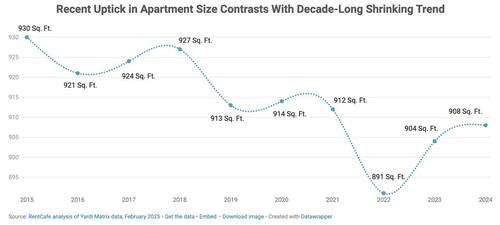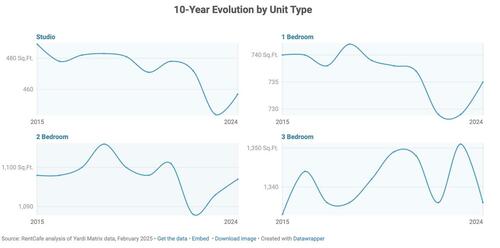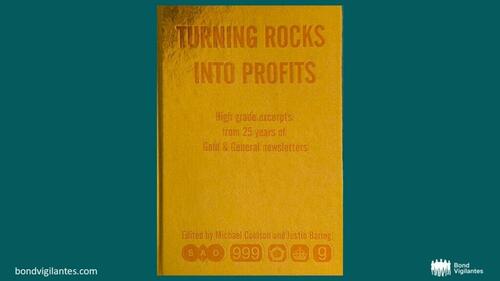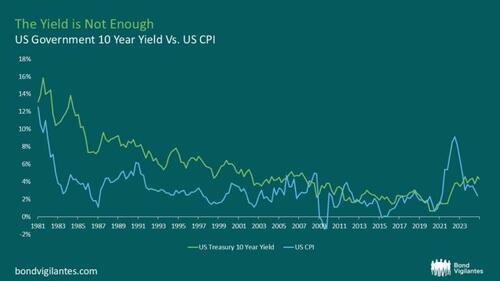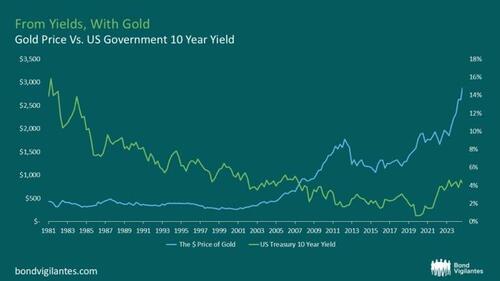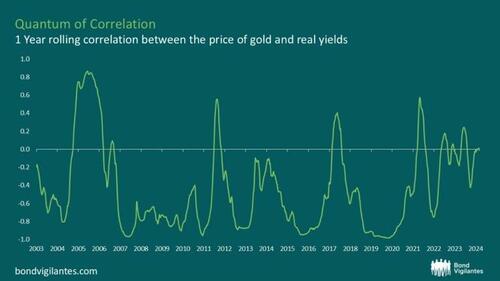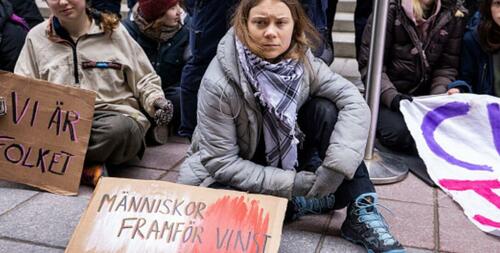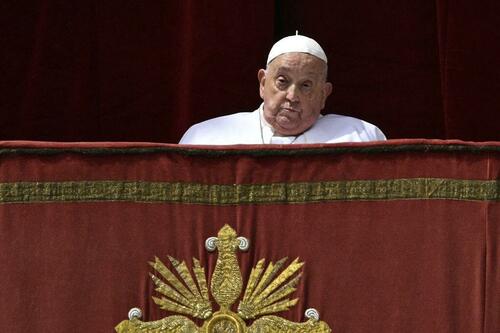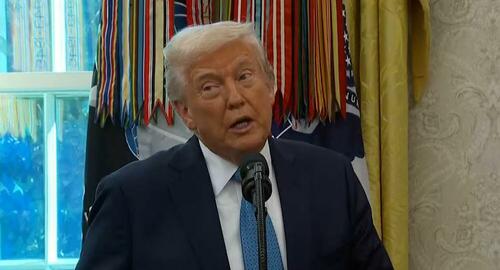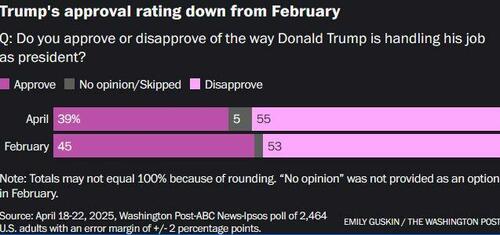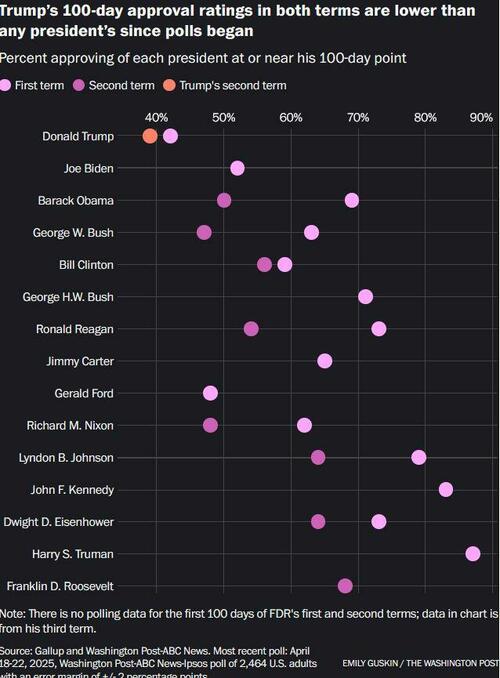Certainly, it is difficult to make the demands of the Gospel understandable to secularized people. But this pastoral difficulty must not lead to compromises with the truth.
Distinction Matter - Subscribed Feeds
-
Site: Mises InstituteHigher education has become unaffordable and its curriculums hopelessly politicized. We should remember that all of this is a result of programs developed more than a half-century ago to make higher education more accessible.
-
Site: Mises InstituteTrump has a great scheme going: impose huge new tariffs (AKA taxes) and then portray a cut on those same tariffs as some sort of generous move.
-
Site: Mundabor's blogI had better things to do on Saturday than to watch Francis’ funeral. However, because I was at home, I did not resist looking a bit on the proceedings. What I saw was not entirely a surprise: a not properly empty, but certainly less than full St Peter’s Square. When you consider that the first […]
-
Site: Zero HedgeApartment Sizes Are Still Shrinking...Except In These Key CitiesTyler Durden Tue, 04/29/2025 - 06:55
As the 2025 rental season kicks off, square footage is becoming the new currency for renters. After a decade of shrinking apartments, new data from RentCafe shows that average unit sizes grew again in 2024, reaching 908 square feet — a reversal driven largely by market demand for more livable space, according to RentCafe.
In 2024, the average U.S. apartment size grew to 908 square feet, reversing a decade-long trend of shrinking floorplans. Studios, one-bedrooms, and two-bedrooms all expanded slightly, gaining between 4 and 13 square feet. Florida cities Tallahassee and Gainesville topped the list for largest average apartment sizes, while Seattle retained its title for the smallest.
Among major markets, San Francisco led the growth with an average unit increase of 59 square feet over the last decade, followed closely by Queens, New York. Marietta, GA, saw the most dramatic jump overall, with new apartments adding 100 square feet compared to those built before 2015, highlighting a broader market shift toward larger, more livable rental spaces.
Studios, one-bedroom, and two-bedroom units all expanded slightly over the past year, adding between 4 and 13 square feet. Developers, responding to consumer preference, heavily favored one-bedroom units, which made up nearly half of all new apartments built.
The RentCafe report says that Florida cities Tallahassee and Gainesville lead the nation for the largest new apartments, with Tallahassee units averaging 1,130 square feet despite a small decline from older stock. Baton Rouge, Knoxville, and Marietta, GA, round out the top five. In fact, Marietta posted the largest growth overall, with new apartments boasting 100 more square feet compared to those built before 2015.
At the same time, big-city hubs like San Francisco and New York’s Queens are seeing apartments expand after years of contraction. San Francisco units grew by 59 square feet over the last decade, while Queens added 39 square feet. Still, Seattle remains the city with the smallest new apartments, averaging just 649 square feet — a steep 57-square-foot drop compared to a decade ago.
Not every city followed the trend toward larger spaces. Arlington, TX, saw the sharpest decline, with new units shrinking by an average of 215 square feet. Detroit, Memphis, and Birmingham also experienced significant reductions as developers prioritized smaller, more affordable units, the report concludes.
RentCafe's report, based on Yardi Matrix data, analyzed apartment sizes across the 100 largest U.S. rental markets as of February 2025. The findings reveal a clear shift: where the market allows, renters are demanding — and developers are delivering — more breathing room.
-
Site: Catholic Herald
Each day between now and the May 7 conclave to elect a successor to Pope Francis, John Allen is offering a profile of a different papabile, the Italian term for a man who could be pope. There’s no scientific way to identity these contenders; it’s mostly a matter of weighing reputations, positions held and influence wielded over the years. There’s also certainly no guarantee one of these candidates will emerge wearing white; as an old bit of Roman wisdom has it, “He who enters a conclave as a pope exits as a cardinal.” These are, however, the leading names drawing buzz in Rome right now, at least ensuring they will get a look. Knowing who these men are also suggests issues and qualities other cardinals see as desirable heading into the election.
ROME – Pope Francis famously bucked convention by living not in the traditional papal apartment in the Apostolic Palace but rather the Casa Santa Marta. But suppose the maverick pontiff had taken things a step further and decided to relocate not merely from one Vatican spot to another, but outside Rome altogether?
A good case could be made that given the pontiff’s social and political priorities, he might well have chosen Marseille in France – where he would have found a highly congenial host in the 66-year-old Cardinal Jean-Marc Aveline, often described as the late pontiff’s favorite bishop.
Marseille is, and always has been, a port city, making it a natural crossroads of peoples, cultures and faiths. Today roughly 25 percent of the population is Muslim, mostly immigrants from North Africa. It’s also a place of contrasts between great wealth and heartbreaking poverty in the immigrant neighborhoods on the northern outskirts of the city known as the quartiers nord. It’s a key point of encounter for the entire Mediterranean region, which Francis often termed the world’s largest outdoor graveyard for all the migrants and refugees who’ve died trying to make the crossing into Europe. As a coastal city it’s a good spot to assess the impact of climate change, including rising temperatures, more frequent heat waves and coastal erosion.
Pope Francis visited Marseille in September 2023, a trip in which the pope’s fondness for the city, and for its chief shepherd, seemed obvious.
Born in Algeria into a family of pied-noir, meaning Europeans (in this case Spaniards) who had settled in Algeria during the era of French colonization, at four years old Aveline and his family were forced into exile after a bloody war of independence. They eventually settled in Marseille in 1965, giving the future cardinal a natural sympathy for migrants and refugees since he lived their experience himself. Among other things, Aveline speaks Arabic, allowing him to communicate with his city’s immigration population in its native tongue.
Aveline had two sisters, both of whom have died, but his parents are still alive and living in Marseille, where he devotes a share of his personal time to helping take care of them.
After discerning a vocation to the priesthood, Aveline would study in seminaries in Avignon and Paris, and was ordained in 1984. Perceived as a gifted intellectual, Aveline would teach theology and run an interdiocesan seminary in Marseille, then moved on as an instructor in theology to the Catholic University of Lyon.
Aveline was known as the “spiritual son” of the late Cardinal Roger Etchegaray, who himself had served as the Archbishop of Marseille before moving on to run the Vatican’s Pontifical Council for Justice and Peace. Throughout his career Etchegaray was known as a man of deep culture and great openness, committed to listening and dialogue – all qualities which most observed attribute to his protégé as well.
After Francis was elected to the papacy in March 2013, he missed almost no opportunity to propel Aveline’s career, naming him an auxiliary bishop of Marseille in December 2013, then Archbishop of Marseille in August 2019, and finally naming him a cardinal in August 2022.
It’s not just the late pontiff who exuded fondness and trust in Aveline; earlier this month he was elected the new president of the French bishops’ conference, with one of his fellow prelates, Bishop Renauld de Dinechin of Soissons, Laon and Saint-Quentin, gushing that “the cardinal is fraternal, joyful and encouraging, with a great intelligence … he is appreciated by all.”
He also gets good reviews in secular circles, having been inducted into the country’s prestigious Légion d’honneur in 2002 by French President Emmanuel Macron.
Progressive Catholics especially tend to like what they see in Aveline. In some French Catholic circles he’s known as “John XXIV,” a reference not only to the reform-minded spirit of “Good Pope John” and the Second Vatican Council, but also to the fact that the smiling, somewhat frumpy and roly-poly Aveline bears a striking physical resemblance to John XXIII.
Yet Aveline is not an ideologue, and at various times over his career has been willing to buck liberal orthodoxy.
For instance, he’s not an advocate of uncontrolled immigration and has said that anyone who is “certainly doesn’t live in certain neighborhoods of many cities marked by a high unemployment rate, the drug trade, degradation and a lack of security.”
Aveline has also shown some sympathy to French Catholicism’s small but influential traditionalist wing. Among other things, he tried unsuccessfully to mediate a dispute in the Diocese of Toulon between Bishop Dominque Rey, who’s a personal friend, and the Vatican over issues such as welcoming traditionalist movements and ordaining large numbers of priests attached to the old Latin Mass. In the end, Rey was compelled to resign anyway in January, but traditionalists nonetheless remember Aveline’s efforts to help.
In general, Aveline is seen as a figure almost impossible to dislike on a personal level, a figure with broadly progressive positions but who’s open to those with more conservative inclinations, and a prelate with a nimble mind, a solid work ethic, and a good heart.
The case for Aveline as pope?
If you’re looking for someone to continue the Pope Francis legacy but perhaps with a bit more consideration for Catholics of differing temperaments, someone capable of reducing the internal tensions in the church rather than to exacerbating them, Aveline might have a great deal of appeal.
Moreover, his background in Marseille certainly has equipped Aveline to face most of the major social and cultural challenges of the early 21st century, from immigration and inter-faith relations to poverty and the environment.
Aveline’s affable personality and charm would also make him a compelling figure on the global stage, a sort of antipode to the in-your-face dynamics of the Donald Trumps of the world. That would be a good look for the Catholic Church, perhaps even helping to revive its missionary fortunes.
All that helps explain why Aveline seems to be attracting a good deal of interest, and not just among the usual European suspects. Right now, for instance, several Latin American cardinals are said to be favorably inclined to his candidacy, seeing him as a figure with a properly global perspective on the church.
The case against?
For one thing, Aveline is French, which for centuries has been though to be disqualifying for a potential pope because of the legacy of the Avignon captivity of the papacy, a dark chapter of history no one is eager to revive. Almost seven centuries later, however, perhaps electors are finally ready to let that old prejudice drop, especially because Aveline is such a supporter not only of European integration but also Mediterranean.
In addition, Aveline doesn’t really speak Italian, which is an obvious handicap for a potential Bishop of Rome. He does have a capacity for languages, however, and could probably learn; in the meantime, the way he stirs memories of John XXIII might be enough to earn him all the Italian street cred he really needs.
Aveline’s age, 66, could possibly be a stumbling block for some cardinals. Should he remain in office to the same age as Pope Francis, 88, that would make for a 22-year pontificate, which might be seen as awfully long – though others might find the stability such a scenario would imply to be reassuring.
Most basically, if you’re a cardinal who found compelling the recent prayer for the conclave released by 94-year-old Cardinal Camillo Ruini, especially his plea for “the certainty of truth and the security of doctrine,” it’s not clear Aveline would be your candidate. While he hasn’t taken strong public positions on most contested theological questions, playing his cards close to the vest, his generally progressive outlook probably won’t reassure those looking for something more predictable and conventional.
Supposedly, Aveline once told someone concerned the cardinal was being overtaxed that, “Each time the weight of your workload is increased, you must lengthen the time of your prayer.”
It remains to be seen if he’s going to have to fall back on that rule in a whole new way should he be the man to step onto the central loggia of St. Peter’s Basilica wearing white. If that happens, one would have to imagine Pope Francis looking down from heaven with satisfaction; more than once, after all, he predicted that his successor would be named John XXIV.
(Photo by LIONEL BONAVENTURE/AFP via Getty Images)

The post Papabile of the day: Cardinal Jean-Marc Aveline emerges as a unifier with a global vision first appeared on Catholic Herald.
The post Papabile of the day: Cardinal Jean-Marc Aveline emerges as a unifier with a global vision appeared first on Catholic Herald.
-
Site: Zero HedgeThe Parable Of GoldfingerTyler Durden Tue, 04/29/2025 - 06:30
Authored by Alexander Zemek-Parkinson via BondVigiliantes.com,
Is there a relationship between the price of gold and bonds? Most vigilantes would agree that there is some correlation based on inflation, with bond yields and the price of gold rising when inflation is on the way up, and vice versa. Most “goldbugs” would probably agree with this assessment. They would say that the metal was a repository of long-term value and was an effective medium for protecting purchasing power. The late Julian Baring was the man with the golden fund1. He presented the relative purchasing power of gold in terms of fixed-price menus at the Savoy, an exercise he frequently undertook with M&G’s former CEO Paddy Lineker. Baring’s results were somewhat mixed, but there can be no doubt of his conclusion that, over time, the gold price not only equalled but outpaced the rate of inflation. It would be easy to conclude, in today’s world of rising bond yields and a historically high gold price, that there is a correlation, and that it is still valid.
But is it? An answer to this can be found in Ian Fleming’s novel, Goldfinger.
Before we turn our attention to Bond, Treasury Bond… Let me enlighten you on the secret life of Ian Fleming. He worked at (but not for) the Bank of England, and in both the film and the novel, he stages a well-crafted scene in one of its palatial offices. He introduces us to a fictional Colonel Smithers, whose job it was to monitor the quantity of gold in the vaults and to stem any bullion ‘leakage’ (smuggling to you and me). Enter the evil Auric Goldfinger, who leads Bond on a merry chase across Europe and the US.
Part of that chase takes Bond to Geneva, where Fleming attended university. Here’s where things get interesting. Goldfinger’s lair where he melts down his gold Rolls-Royce, is on the outskirts of a small village called Coppet4. Fleming gives a detailed description of the village’s ancient chateau, the small forest behind it and the position of a building which houses his foundry. This all exists in real life, except that the foundry is actually the tomb of one of the earliest Bond Vigilantes: the banker Jacques Necker, who was a finance minister under Louis XVI. Necker was popular because he thought debt finance was preferable to placing a heavier tax burden on the public.
Central to Necker’s concept of debt finance was the establishment of a central bank along British principles and a beneficial partnership between sovereign and private investors. System and laws were all-important. He succeeded in raising substantial loans for the beleaguered King as the nation’s political scene deteriorated. His scheme worked for a while, but the debt he created expired worthless. Necker got the sack, the King met the guillotine and a popular government was installed. In its place came the revolutionary interest-free fiat currency called the Assignat. These bills came with a dark warning on their borders5: “Death to counterfeiters, and rewards to denouncers”.
I’ve decided that none of this is a coincidence (or I wouldn’t have an article). What is Fleming actually trying to tell us? The message is clear that there is a link between debt and the value of gold. But does it hold true for inflation?
Below is a graph that is going to come as no surprise to the contemporary Bond Vigilante. It shows an observable correlation between bond yields and CPI. When inflation goes up, bond yields go up. When it comes down, bond yields come down. Nothing exciting.
Source: Bloomberg
Now, let’s look at that again with the same bonds but set against the price of gold instead. We are looking for moments where the yield on the bonds fall and the gold price goes up to seek out some form of correlation between the two asset classes that we are told by textbooks exists.
Source: Bloomberg
Admittedly, a tricky graph there but there are a couple of times where we can see this in action. We see in ’82, ’87 and ’07 clear points where the yields fell and the gold price went up reflecting the ‘flight to safety’ that these trades tend to represent. So we are seeing a negative correlation in action. This sort of thing happens at times of market distress and when things in global markets look dicey.
Of late though, once you dial in on the rolling correlation between the price of gold and the real yield of US Treasuries over the last 20 years, that relationship has begun to break down. In the last 5 years, the correlation has hovered around zero thanks to the recent rise in the gold price. So quite literally there is no correlation between the two assets (and we know there has certainly been market distress recently).
Source: https://www.longtermtrends.net/gold-vs-real-yields/
So what then should we make of gold recently breaking the $3,000 mark? Is this significant for bond markets? Yes.
Things become clearer when we start considering broader macroeconomic movements over the last 50 years. From the 1980s onward, global market dynamics started to change with the introduction of Reaganomics, the Cold War summit and the widespread acceptance of globalisation. The world got smaller and the peace dividend grew, and with it came the development of broad mechanisms for an international system of freer trade. To the astonishment of Julian Baring, bond prices flew as global inflation fell and international cooperation improved. Bond risk premia dwindled.
Then, with the credit crisis of 2007 and the sovereign debt crisis of 2009, gold got moving again and made up for lost time. Why? Fear and uncertainty needled their way back into the bond markets and to gold’s residual value. In both government and commercial bond markets, investors began to demand higher yields8 because the benefits of globalisation seemed to be fast-disappearing9. We now appear to face a more uncertain macroeconomic environment, and quantitative easing, which eventually supported bond prices at artificially high levels, has gone into reverse. Just as the peace dividend now seems to be on the wane, the risk vectors have begun to rise.
Fleming, at the time of Goldfinger, was facing another series of global transformations: the wane of the Bretton Woods system, the possible change of the pound to a fiat currency and their effect upon the fabric of British social and political constructs10.
Gold has begun to behave like wampum, tulip bulbs and beanie babies11, bubble assets whose unexplained residual value eclipsed their intrinsic value and whose price reflects something other than the commodity it represents. To return to Mr. Baring, the Savoy index would now tell us that a single gold sovereign could buy you roughly 15 meals (a historic high). But where exactly is gold’s additional residual value coming from? I’d return to our friend Colonel Smithers, who supplied the moral to this, our Goldfinger parable.
Whilst bonds are the barometer of trust and faith in a system, Smithers maintains that…
“Gold is the talisman of fear”.
-
Site: RT - News
The struggle will continue even after the US leader puts the EU and UK in their place, Dmitry Medvedev has said
Western European leaders are waging a “quiet war” against US President Donald Trump, former Russian President Dmitry Medvedev has claimed.
Washington’s current tariffs standoff and disagreements on NATO spending with the EU and UK is not only an economic but also an ideological conflict, Medvedev, who currently serves as the deputy chairman of Russia’s Security Council, said on Tuesday.
“I have no doubt that [Western] Europe will be put in its place [by the US], but at the same time the Europeans will continue their quiet war against Trump. They will try to wage a war against him on all possible fronts, observing the rules of decency on the outside. What will come of it – we will see,” he stated.
The tensions between Washington on one side and the EU and UK on the other are explained by the fact that “in [Western] Europe, neo-globalist forces are still in power, trying to pursue the previous course, including the course against our country... But in the US, other forces have taken the reins. These are conservative, more traditionalist forces that want to calm the situation and, in a certain sense, achieve reconciliation with Russia,” the former president said at the ‘Knowledge. First’ educational event in Moscow.
READ MORE: ‘Real de-Nazification’ would include all Europe – Medvedev
“One does not need to be a prophet" to predict that the US will likely prevail against Western Europe, he stressed.
“It will happen because the American economy is much stronger than the European one, despite the fact that the latter is also a huge economy. Nevertheless, it is still a segmented conglomerate of countries, even with the existence of the EU. And I am not even talking about the fact that an overwhelming majority of military forces and armaments are concentrated in the US,” Medvedev explained.
-
Site: Catholic Herald
ROME – As cardinals meet in Rome ahead of a conclave to elect the next pope, a Peruvian cardinal accused of sexual abuse and whose ministry was restricted by Pope Francis has joined private meetings with his fellow red-hatters.
Vatican spokesman Matteo Bruni said April 28 that during a morning session of pre-conclave general congregations that day, cardinals discussed “issues of relevance for the future of the Church”.
These topics, he said, included “the relationship with the modern world and some challenges that are highlighted, such as evangelisation, relations with other faiths, and the issue of abuse. They spoke about the qualities the new pontiff will have to possess in order to respond to these challenges.”
The discussion on abuse and who will be up to the task of credibly tackling it by the roughly 180 cardinals present, over a 100 of whom are eligible to vote in the conclave, came the day after a cardinal who had been sanctioned by Pope Francis for sexual abuse was seen at a public event with his fellow prelates paying homage to the late pontiff, and after he was seen leaving the hall where the meetings are taking place.
 Cardinal Juan Luis Cipriani leaves the Vatican’s Paul VI Hall, where pre-conclave general congregation meetings are taking place, April 28, 2025. (Credit: Ampliacion de Noticias/Screenshot.)
Cardinal Juan Luis Cipriani leaves the Vatican’s Paul VI Hall, where pre-conclave general congregation meetings are taking place, April 28, 2025. (Credit: Ampliacion de Noticias/Screenshot.)
For decades, Peruvian Cardinal Juan Luis Cipriani, 81, was among the most prominent and influential prelates for the Catholic right in Peru and throughout Latin America, especially during his two decades as archbishop of Lima, where he served from 1999-2019.
In January it was revealed publicly in Spanish newspaper El Pais that Cipriani had been accused of sexually abusing an adolescent boy and sanctioned by Pope Francis in 2019, with restrictions on participation in a conclave and on donning cardinal attire.
An individual who chose to remain anonymous claimed that in 1983, between 16-17 years of age, he was sexually assaulted by Cipriani in the confessional and remained silent for years before finally deciding to make a complaint to the pope in 2018.
A previous complaint made against Cipriani to the Vatican in 2002 apparently came to nothing, while the 2018 complaint resulted in Cipriani’s prompt retirement in January 2019, shortly after reaching the mandatory retirement age of 75, and restrictions on his ministry.
These restrictions apparently barred him from wearing his red cardinal robes and other symbols associated with the cardinalate, from returning to Peru without permission, and from participating in a future conclave. He is now 81, over the age limit for cardinals to participate in a conclave.
RELATED: Once powerful Peru cardinal denies allegations of sexual abuse
However, Cipriani is currently in Rome and was seen visiting Pope Francis while lying in state, and at an April 27 Vespers service in the Basilica of St. Mary Major, where Francis is buried, after visiting his tomb.
He was also seen leaving the hall where general congregations are taking place, dressed in his cardinal attire despite having been banned from doing so.
After news of the allegations against Cipriani went public in January, Bruni confirmed the restrictions on Cipriani’s ministry to media, saying that after the accusation was made in 2018, and after the acceptance of his resignation as archbishop of Lima in 2019, “the cardinal was imposed a penal precept with some disciplinary measures”.
These measures, Bruni said, were “related to his public activity, place of residence and use of insignia,” and were “signed and accepted” by Cipriani himself.
Bruni at the time clarified that the restrictions “appear to still be in force”.
Cipriani has repeatedly denied the allegations, calling them “completely false” and saying he never committed any crime, arguing that the alleged victims’ claims were a misunderstanding of his efforts to be pastorally close to the young man after he lost his father.
While acknowledging the restrictions on his ministry, imposed directly by Pope Francis, he also argued that the pope had not followed due process and compared himself to Australian Cardinal George Pell, who was imprisoned after being accused of sexual abuse only to be acquitted later.
RELATED: Peruvian bishops back pope, accuser of once powerful cardinal
In the wake of Cipriani’s denials and the backlash that the allegations against him created, Cardinal Carlos Castillo of Lima, Cipriani’s successor as archbishop of Lima, issued a statement supporting the alleged victim and the pope.
Two months later, on March 28, Cipriani published another statement in which he asked the Peruvian bishops to rectify their communique announcing the restrictions on him, which they said were imposed after “the proof of the facts was ascertained”.
He said there was no formal process with a presenting of proofs or a right to defense, no witnesses, and no judgement. He called the communique defamatory, especially given his status as a cardinal, and said it was the bishops’ responsibility to rectify their mistake.
In an April 7 communique responding to Cipriani’s statement, the Peruvian Episcopal Conference (CEP) said the pope in his decision to impose sanctions on Cipriani in the manner in which he did exercised “pastoral charity” and justice.
They said the restrictions against Cipriani “remain in force” and had been agreed and signed off on by Cipriani himself.
“While Cipriani has every right to affirm his innocence, since guilt is proven in a criminal trial, however, it is no less true that a penal precept exists; for this reason, he should not forget the exquisite pastoral charity of the Holy Father,” the CEP said.
Despite Cipriani’s insistence on a lack of due process, the CEP’s confirmation that a penal precept exists, presumably with additional penalties for failure to comply with the restrictions imposed on his ministry, raise serious questions about his proximity to cardinals ahead of the conclave, especially in light of discussion on abuse.
Bruni during Monday’s press conference did not confirm whether Cipriani was participating in the general congregation meetings, and did not offer indications on whether the sanctions against Cipriani for sexual abuse barred him from participating.
“All cardinals are able to participate” in the general congregations, he said, saying the Vatican constitution outlining the rules of a conclave, Universi Dominici Gregis, is clear in this regard.
In a statement following Monday’s general congregation, victims’ advocacy group Bishop Accountability condemned Cipriani’s presence at the meetings.
“The inclusion of a credibly accused cardinal in this week’s important pre-conclave meetings exposes the disconnect between the Church’s words and actions on abuse,” the statement said, saying Cipriani’s presence “mocks the cardinals’ statement about the supposed importance of the abuse issue”.
His participation “reassures abusive bishops of their colleagues’ continuing support even as it sends a distressing message to abuse victims. It revives the haunting idea that the church is safer for accused clergy than for children,” the organisation said.
Bishop Accountability said that even more concerning than Cipriani’s participation in the pre-conclave discussions is “the dysfunction of the Vatican even when it does the right thing”.
They questioned why Cipriani would be allowed to participate, after having been sanctioned by Pope Francis for sexual abuse, and questioned the logic of referring to Universi Dominici Gregis as a justification.
According to paragraph seven in chapter two of the document, all cardinals are summoned “who are not legitimately impeded”.
“If punishment imposed by the pope himself for a cardinal’s sexual assault of a child doesn’t constitute a ‘legitimate impediment,’ what on earth does?” the organisation asked.
While they applauded the cardinals’ commitment to tackling abuse as a priority in electing the next pope, Bishop Accountability said, “including an alleged abuser in their meetings discredits their words”.
“The cardinals must show that they mean what they say, and that means immediately banning Cipriani…and any other culpable church leader from the rest of their meetings,” they said.
This article was updated with a statement from Bishop Accountability.
Follow Elise Ann Allen on X: @eliseannallen
(Photo by VINCENZO PINTO/AFP via Getty Images)

The post Controversy erupts as sanctioned Cardinal attends pre-conclave meetings first appeared on Catholic Herald.
The post Controversy erupts as sanctioned Cardinal attends pre-conclave meetings appeared first on Catholic Herald.
-
Site: Mises Institute
-
Site: Zero HedgeVisualizing AI vs. Human Performance In Technical TasksTyler Durden Tue, 04/29/2025 - 05:45
The gap between human and machine reasoning is narrowing...and fast.
Over the past year, AI systems have continued to see rapid advancements, surpassing human performance in technical tasks where they previously fell short, such as advanced math and visual reasoning.
This graphic, via Visual Capitalist's Kayla Zhu, visualizes AI systems’ performance relative to human baselines for eight AI benchmarks measuring tasks including:
-
Image classification
-
Visual reasoning
-
Medium-level reading comprehension
-
English language understanding
-
Multitask language understanding
-
Competition-level mathematics
-
PhD-level science questions
-
Multimodal understanding and reasoning
This visualization is part of Visual Capitalist’s AI Week, sponsored by Terzo. Data comes from the Stanford University 2025 AI Index Report.
An AI benchmark is a standardized test used to evaluate the performance and capabilities of AI systems on specific tasks.
AI Models Are Surpassing Humans in Technical Tasks
Below, we show how AI models have performed relative to the human baseline in various technical tasks in recent years.
Year Perfomance relative to the human baseline (100%) Task 2012 89.15% Image classification 2013 91.42% Image classification 2014 96.94% Image classification 2015 99.47% Image classification 2016 100.74% Image classification 2016 80.09% Visual reasoning 2017 101.37% Image classification 2017 82.35% Medium-level reading comprehension 2017 86.49% Visual reasoning 2018 102.85% Image classification 2018 96.23% Medium-level reading comprehension 2018 86.70% Visual reasoning 2019 103.75% Image classification 2019 36.08% Multitask language understanding 2019 103.27% Medium-level reading comprehension 2019 94.21% English language understanding 2019 90.67% Visual reasoning 2020 104.11% Image classification 2020 60.02% Multitask language understanding 2020 103.92% Medium-level reading comprehension 2020 99.44% English language understanding 2020 91.38% Visual reasoning 2021 104.34% Image classification 2021 7.67% Competition-level mathematics 2021 66.82% Multitask language understanding 2021 104.15% Medium-level reading comprehension 2021 101.56% English language understanding 2021 102.48% Visual reasoning 2022 103.98% Image classification 2022 57.56% Competition-level mathematics 2022 83.74% Multitask language understanding 2022 101.67% English language understanding 2022 104.36% Visual reasoning 2023 47.78% PhD-level science questions 2023 93.67% Competition-level mathematics 2023 96.21% Multitask language understanding 2023 71.91% Multimodal understanding and reasoning 2024 108.00% PhD-level science questions 2024 108.78% Competition-level mathematics 2024 102.78% Multitask language understanding 2024 94.67% Multimodal understanding and reasoning 2024 101.78% English language understandingFrom ChatGPT to Gemini, many of the world’s leading AI models are surpassing the human baseline in a range of technical tasks.
The only task where AI systems still haven’t caught up to humans is multimodal understanding and reasoning, which involves processing and reasoning across multiple formats and disciplines, such as images, charts, and diagrams.
However, the gap is closing quickly.
In 2024, OpenAI’s o1 model scored 78.2% on MMMU, a benchmark that evaluates models on multi-discipline tasks demanding college-level subject knowledge.
This was just 4.4 percentage points below the human benchmark of 82.6%. The o1 model also has one of the lowest hallucination rates out of all AI models.
This was major jump from the end of 2023, where Google Gemini scored just 59.4%, highlighting the rapid improvement of AI performance in these technical tasks.
To dive into all the AI Week content, visit our AI content hub, brought to you by Terzo.
To learn more about the global AI industry, check out this graphic that visualizes which countries are winning the AI patent race.
-
-
Site: LES FEMMES - THE TRUTH
-
Site: Real Investment Advice
When planning for retirement, securing a reliable income stream is a top priority. Many retirees turn to annuities for retirement income as a way to guarantee financial stability. Guaranteed income strategies help retirees maintain cash flow throughout their lives, reducing the risk of outliving their savings.
However, while annuities offer security and predictability, they also come with limitations, fees, and liquidity restrictions that should be carefully considered. In this guide, we’ll explore what annuities are, the different types available, their benefits and risks, and when they make sense in a retirement income plan.
What Are Annuities?
An annuity is a financial product designed to provide a steady stream of income in exchange for an upfront investment. Insurance companies typically offer annuities, which can be customized based on payout schedules, growth potential, and risk preferences.
Retirees often use annuities as part of their guaranteed income strategies, ensuring financial stability throughout their lifetime.
Types of Annuities
There are several types of annuities, each offering different benefits and risk levels.
1. Fixed Annuities
- Provide a guaranteed fixed interest rate over a set period.
- Offer predictable income with low risk.
- Ideal for conservative investors seeking stability.
Best for: Retirees who want secure and steady payments without market exposure.
2. Variable Annuities
- Funds are invested in mutual fund-like subaccounts, which fluctuate with market conditions.
- Income potential is higher, but payments are not guaranteed.
- Fees can be high due to investment management costs.
Best for: Investors willing to accept market risk for higher potential returns.
3. Indexed Annuities
- Earnings are tied to a stock market index (e.g., S&P 500) with a guaranteed minimum return.
- Offer some growth potential with downside protection.
- Typically have caps on returns and complex fee structures.
Best for: Retirees who want market-linked returns with some level of downside protection.
The Benefits of Annuities for Retirement Income
1. Guaranteed Lifetime Income
One of the primary advantages of annuities is their ability to provide lifetime income, reducing the risk of outliving savings. Payouts can last for life, depending on the contract terms.
2. Tax-Deferred Growth
Earnings within an annuity grow tax-deferred until withdrawals begin, allowing for potentially greater accumulation over time.
3. Customizable Payout Options
- Immediate annuities begin payments soon after the initial investment.
- Deferred annuities allow funds to grow before withdrawals start at a later date.
- Payouts can be structured for life, a set period, or joint spousal coverage.
4. Protection Against Market Volatility
Unlike stocks and bonds, fixed annuities are not affected by stock market downturns, providing stable income regardless of economic conditions.
5. Can Supplement Other Retirement Income
Annuities can complement Social Security, pensions, and investment withdrawals, creating a well-rounded retirement income plan.
The Risks and Drawbacks of Annuities
While annuities offer security, they also come with limitations that should be carefully evaluated.
1. High Fees and Expenses
- Variable and indexed annuities can have high management fees.
- Surrender charges may apply if you withdraw early.
- Riders and additional features often increase costs.
2. Limited Liquidity
- Many annuities lock funds for years, making it difficult to access cash.
- Withdrawals beyond contract limits can trigger penalties and taxes.
3. Inflation Risk
- Fixed annuities provide stable payments, but they may lose value over time due to inflation.
- To combat this, some contracts offer inflation-adjusted payout options.
4. Complex Terms and Conditions
- Annuity contracts can be complicated, with varying rules on withdrawals, payouts, and fees.
- Understanding the fine print is crucial before committing.
When Do Annuities Make Sense in a Retirement Income Plan?
Annuities are not for everyone, but they can be a valuable tool when used strategically.
You May Benefit from an Annuity If:
- You need guaranteed income beyond Social Security and pensions.
- You are risk-averse and want a predictable cash flow.
- You are concerned about outliving your savings.
- You won’t need immediate access to the invested capital.
Annuities May NOT Be Ideal If:
- You prefer investment flexibility with higher growth potential.
- You need liquidity for unexpected expenses.
- You have other guaranteed income sources that cover your needs.
Should You Consider an Annuity?
Annuities can be a valuable addition to a retirement income strategy, offering stability, predictable income, and tax advantages. However, they also come with fees, liquidity restrictions, and potential inflation risks.
Before purchasing an annuity, it’s essential to understand the different types, weigh the benefits and risks, and determine if it aligns with your financial goals.
At RIA Advisors, we help retirees evaluate annuity options and build customized income strategies for long-term security. Contact us today to discuss whether an annuity is right for you.
FAQs
What is the biggest advantage of annuities for retirement income?
The primary benefit is guaranteed lifetime income, ensuring retirees won’t outlive their savings.
Are annuities better than traditional investments?
It depends on your financial goals. Annuities provide stability, while stocks and bonds offer higher growth potential but more risk.
Can I access my money in an annuity?
Annuities typically have withdrawal restrictions and surrender charges if accessed early. Some contracts offer limited penalty-free withdrawals.
How are annuities taxed?
Earnings grow tax-deferred, but withdrawals are taxed as ordinary income. Annuities purchased with after-tax dollars may have tax advantages.
Who should consider an annuity?
Annuities are best for retirees seeking stable, predictable income with little market exposure. They are not ideal for those needing immediate liquidity.
The post Understanding the Benefits and Risks of Annuities for Retirement Income appeared first on RIA.
-
Site: Crisis Magazine

I was nearly ten years old when Pope St. John Paul II died. I remember watching his funeral on the tiny television in the corner of our kitchen. Being so young, I had no significant grasp of who the Polish pope was—and never could have imagined that, some years later, my Polish wife and I would tour the very Kraków where Karol Wojtyła had served as archbishop. But I knew that he was the Holy…
-
Site: RT - News
Nearly 60% of those surveyed negatively assessed the billionaire’s role in US President Donald Trump’s administration
The majority of Americans disapprove of Elon Musk’s performance of his role within the US government, according to a new poll conducted by ABC News, the Washington Post, and Ipsos. Musk recently announced plans to scale back his involvement as head of the Department of Government Efficiency (DOGE).
Of the respondents, 57% said they disapprove of Musk’s job performance in the administration led by Donald Trump, while 35% said they approve of what has been done so far, ABC News reported on Monday. The outlet noted that opposition to the administration’s efforts to shrink the federal government – spearheaded by DOGE – is a key driver of the negative ratings.
In recent months, the White House, through DOGE, has implemented widespread federal spending cuts. Under the department, which was established by Trump shortly after taking office in January, roughly 280,000 federal employees have reportedly been laid off in an effort to balance the US federal budget.
Earlier this month, thousands of Americans took to the streets across the country to protest what they described as an “illegal power grab” and “coup” by Trump and Musk, claiming that the economic and social policies enacted by the president and his ally have plunged the country into a full-blown crisis.
READ MORE: White House to evaluate officials’ loyalty to Trump – WSJ
Last week, Musk stated he would scale back his involvement as head of DOGE and refocus on his business interests, saying that the “major work” to establish the department had been completed. The world’s richest man clarified, however, that he has no plans to step away from government work entirely, and that he would still devote “a day or two per week to government matters.”
Musk’s role as a special government employee is expected to conclude by late May. After that, he is expected to return his focus to his private ventures, which include Tesla, the rocket company SpaceX, and the social media platform X, among others.
-
Site: RT - News
The US president has said bypassing the constitutional limit in 2028 would be a “hard thing to do”
US President Donald Trump has ruled out seeking a third term, despite previously hinting at the possibility on multiple occasions.
In an interview with The Atlantic, published on Monday and marking his first 100 days in office, Trump was asked about a rumor that he had directed the US Justice Department to examine whether it would be legal for him to run again in 2028, when he will turn 82.
He stated that he had not done so but appeared to leave the possibility open, suggesting that he might be reluctant to break the democratic norm.
“That would be a big shattering, wouldn’t it?” He mused. “Well, maybe I’m just trying to shatter.”
Trump pointed out that his supporters had often urged him to run for a third term, but that he ultimately dismissed the idea, insisting that he has had no actual plans to stay in office beyond his second term.
Read more Trump starts selling 2028 election hats
Trump starts selling 2028 election hats
“It’s not something that I’m looking to do. And I think it would be a very hard thing to do.”
However, profiting from the idea appears to be a feasible option. Earlier this month, the US president launched a new line of “TRUMP 2028” merchandise, driving speculation about a possible third-term bid.
The official campaign store offers baseball caps and T-shirts, featuring “TRUMP 2028” and the slogan “Rewrite the Rules,” echoing the style of his iconic “Make America Great Again” branding.
Last month, Trump said he is “not joking” about potentially seeking a third term, claiming that there are “methods” to pursue another run despite the US Constitution’s two-term limit on the presidency. His comments fueled fears that he might attempt to overhaul the country’s electoral system in order to remain in power, though several high-profile Republicans dismissed the idea as little more than a joke.
Earlier this year, Republican Congressman Andy Ogles introduced a constitutional amendment that would allow presidents to serve three non-consecutive terms, though it has so far gained little traction.
-
Site: Crisis Magazine

By the time I was nearing high school graduation in the 1970s, my friend Jimmy Patridge, a young Marine, had already returned from Vietnam—missing both of his legs. The sexual revolution of the 1960s was in full swing, abortion had been legalized, and the Church seemed as confused as I was. At the same time, I became aware of two opposing forces: a dark presence in the world, and the voice of my…
-
Site: Mises InstituteUS Navy loses $60 million fighter jet after it fell off aircraft carrier. This brings the total cost of lost aircraft in Yemen up to $270 million since Trump took over.
-
Site: Real Investment Advice
The Zweig Breadth Thrust, a rare technical indicator, triggered a bullish signal on Friday. The signal indicates rapid and significant changes in momentum. The calculation is based on the 10-day moving average of the percentage of stocks that were positive on a daily basis. The Zweig Breadth Thrust signal occurs when the moving average rises from below 40% to above 61.5% within 10 days. It is trying to capture the final capitulation in a downward trend.
A Zweig bullish thrust signal is rare. But it's been a great predictor of positive forward returns when triggered, as shown below. Since 1950, the bullish indicator has only triggered 16 times, not including last Friday. The graph and table below show that in every instance the rare Zweig bullish thrust signal has occurred, it has consistently produced positive returns in the six-month and one-year periods. The shorter-term returns are positive in almost all cases. While this doesn't guarantee the downward trend is over, it does provide optimism that those willing to hold through more volatility and potentially lower lows will ultimately be rewarded.
Check out the Tweet of the Day below. It shares Jason Goepfert's analysis of triggering the even rarer Super Zweig. The Zweig Breadth Thrust and Jason's Super Zweig show average one-year returns, post trigger, in the mid-20s percentage range.

What To Watch Today
Earnings

Economy

Market Trading Update
Yesterday, we discussed the recent breakout above the 20-DMA and the downtrend from the February peak. Last week, saw a strong rally from the recent lows, which put markets back into a short-term overbought condition. As Goldman Sachs noted:
"On April 3, the S&P 500 opened at 5462 (when we got our first look at the now (in)famous tariff board after the close on April 2. Four days later, on April 7th, the S&P 500 made its one-year low of 4835. On Friday, after four consecutive positive trading sessions (S&P 500 gained 735bps during this stretch), we closed at 5525."

It should be unsurprising that after such a strong rally from the lows, and completely retracing the entire tariff decline, markets gave back a bit of the advance yesterday. What is crucial is that the recent breakout of the downtrend holds, without violating the rising trend line from the recent lows as shown. A violation of those levels would suggest a retest of recent lows. Such a decline would likely require either bad news on the tariff front or a collapse in economic data suggesting rising recession risks. Both are likely events at this juncture, and we must remain cautious.

This snippet from yesterday's blog encapsulates our current concerns.
"As the current correction continues, the market has violated the 40-week moving average. This has only happened a handful of times since 2008, namely during:"
- The Euro crisis in 2012
- Brexit in 2015
- The Fed Taper Tantrum in 2018
- COVID in 2020
- Russia/Ukraine War in 2022
- And currently.

"Each one of those corrections ended without a confirmed violation below the 200-week moving average, but each lasted a few months before the bull market returned. As the correction continues, the violation of the 40-week moving average puts us in the position of needing reduced equity risk in portfolios until we begin to see more bullish price action take shape."
Such is why we remain risk-averse for now and added to a short S&P 500 hedge last week.

Correction Continues- The Value Of Risk Management
Despite the recent rally, the correction continues. While wanting to “buy the dip” is tempting, there has been enough technical damage to warrant remaining cautious in the near term. As we have discussed, managing risk requires discipline and the emotional ability to navigate more volatile markets until a more straightforward path for risk-taking emerges. The problem with this statement is that it often immediately gets translated to mean “being entirely out of equities,” which is the act of “market timing.”
That is not what we mean by risk management. Repeated studies have evidenced that the problem with market timing is that individuals cannot successfully replicate the profitable timing of the buys and sells. However, individuals can increase and reduce exposure to risk during periods of higher volatility. This is because the most significant drawdowns tend to occur during periods of increased price volatility. As this correction continues, volatility remains relatively subdued. However, if the economy slips into a recession or some other event disrupts forward earnings expectations, there is undoubtedly a risk of a further increase.

Market Breadth Normalizes
As we led, the Zweig Breadth gauge indicates the potential for resuming the bullish trend. The SimpleVisor graphic below also provides optimism that the recent market decline and significant volatility are ending. Whether this period is a rest bit before further downside pressure, or signals a healing process that will lead to eventual upside, is unclear. As we highlight with the red square, all but three sectors have absolute and relative scores near zero. This entails that most sectors are trading similarly to the market. The absolute scores indicate most sectors are no longer oversold and have room to the upside (become overbought), but they also have room to become oversold again. The second graphic showing factor scores tells a similar story, with many scores near zero.


Tweet of the Day

“Want to achieve better long-term success in managing your portfolio? Here are our 15-trading rules for managing market risks.”
Please subscribe to the daily commentary to receive these updates every morning before the opening bell.
If you found this blog useful, please send it to someone else, share it on social media, or contact us to set up a meeting.
The post A Rare Zweig Breadth Thrust Provides Optimism appeared first on RIA.
-
Site: Zero HedgeLondon Is Losing Its MillionairesTyler Durden Tue, 04/29/2025 - 05:00
Authored by Guy Birchall via The Epoch Times (emphasis ours),
London is losing its richest residents.
The British capital has seen more than 30,000 millionaires vanish over the past 10 years.
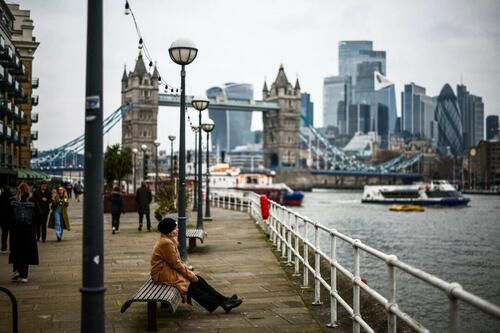 A person sits on a bench next to the River Thames backdropped by the City of London financial district and Tower Bridge in London on Feb. 13, 2025. Henry Nicholls/AFP via Getty Images
A person sits on a bench next to the River Thames backdropped by the City of London financial district and Tower Bridge in London on Feb. 13, 2025. Henry Nicholls/AFP via Getty Images
It has now dropped out of the top 5 cities for millionaires around the world, with New York, the Bay Area, Tokyo, Singapore, and Los Angeles all ranking higher, according to a report commissioned by Henley and Partners, a United Kingdom-based investment migration consultancy.
The firm found that London had lost 11,300 dollar millionaires in just 12 months, including 18 individuals with a net worth of $100 million or more, and two billionaires.
London, which now has 215,700 millionaires, is one of only two cities in the top 50 — the other being the heavily sanctioned capital of Russia, Moscow—that has fewer rich individuals than a decade ago.
In total, the British capital has lost 12 percent of its wealthiest residents since 2014, while Moscow has lost 25 percent.
Many millionaires fled Moscow in the wake of Western sanctions following the invasion of Ukraine in 2022.
Though the Russian capital has lost more millionaires as a percentage over the past decade, with 10,000 leaving, in terms of sheer numbers, London has lost three times that number in the same time frame.
The majority of departures have been to other European countries such as Italy and Switzerland, as well as the United Arab Emirates (UAE).
Dubai, in particular, has seen a huge growth in the number of millionaires over the past decade, increasing by 102 percent.
So what is driving the super-rich out of what was once one of the premier playgrounds of the rich and famous?
Andrew Amoils, head of research at New World Wealth, who carried out the report for Henley and Partners, told The Epoch Times there were numerous factors for London losing some of its wealthiest residents.
He said that rising concerns about crime and safety were the big factors putting the rich off the British capital.
“Safety is one of the key drivers of long-term wealth growth,” Amolis said. “Women and child safety is especially important—the recent child grooming scandal highlighted this crisis.”
Crime and Safety
A number of billionaires in recent months have made similar statements about crime being an issue.
Devin Narang, an Indian entrepreneur, said in a meeting attended by David Lammy, then shadow foreign secretary, that fear of crime in London was one of India’s elite’s biggest concerns about the city.
“People are being mugged in the heart of London–in Mayfair,” Narang, a member of the executive committee of the Federation of Indian Chambers of Commerce and Industry, said at a meeting in New Delhi in February 2024, the Financial Times reported.
“All CEOs in India have had an experience of physical mugging and the police [in London] not responding.”
Manchester United owner Sir Jim Ratcliffe also said that he had stopped wearing luxury watches in the capital.
“I can’t wear a watch in London, and I just need to be a bit wary, a bit careful,” Ratcliffe told The Sunday Times.
Ratcliffe, one of Britain’s wealthiest people, cited the story of a murder over a Rolex picked up on one of his company Ineos’s CCTV cameras at its headquarters in Knightsbridge.
“He died in a pool of blood because somebody tried to take his Rolex, and he resisted. About a year ago, we had three guys in hoodies, with machetes, right outside the office, opposite Harrods.”
More than 6,800 watches were reported stolen in 2023, the latest year for which figures are available, an increase from more than 6,000 in 2022.
Taxes a Turnoff
High taxes are another one of the prime reasons the rich no longer call London home.
Amoils said: “Capital gains tax and estate duty [inheritance tax] rates in the UK are amongst the highest in the world, which deters wealthy business owners and retirees from living there.
“The recent tax rises from the October 2024 budget have exacerbated this issue as they pulled non-doms, farms, and small businesses into the UK estate duty net.”
Non-dom, short for non-domicile, describes a person who lives in the UK, but whose permanent home for tax purposes is outside the country.
It refers to a person’s tax status and has nothing to do with their nationality, citizenship, or resident status, although it can be affected by these factors.
A non-dom previously only paid UK tax on the money they earn in Britain and did not have to pay tax to the British government on money made elsewhere in the world.
In October, the Labour government confirmed plans to abolish non-dom status from April 2025, and to replace it with a residence-based regime, which will also bring foreign earnings into the UK inheritance tax system.
Dwindling Importance
Another factor spurring the movement of millionaires is the fact that the city itself is becoming less globally significant.
“The London Stock Exchange (LSE) was once the largest stock market in the world by market cap, but it now ranks 11th globally,” Amolis said.
“The past two decades have been particularly poor, with a large number of delistings and relatively few new IPOs.
“The continued ascendance of rival financial hubs such as Dubai, Paris, Geneva, Milan, Lugano, Frankfurt, and Amsterdam has eroded London’s status as Europe’s top financial center.”
He added that growing American and Asian dominance of the global space has also prompted several wealthy tech entrepreneurs in the UK to reconsider their base location, with many moving to tech hubs in North America and Europe.
“A lot of the new wealth that has been created in the last decade has mainly been from the tech sector, so if you miss out on that, you are missing out on a huge amount of wealth,” Amolis said.
Amolis also said that the historic appeal of London and the UK was its use of English, which remains either the first or second language of most millionaires globally.
“However, over time, this has become less relevant as the economies of the other major English-speaking countries like the United States, Australia, and Canada have grown,” he said.
“Furthermore, there are now several other high-income markets globally where one can get by only speaking English, including the likes of Singapore, the UAE, New Zealand, and Malta.”
Another factor is that part of the drop in the number of wealthy people in London is not necessarily that they left the city; they just became less well off due to the drop-off in the stock market and a worsening exchange rate of the pound against the dollar.
“A lot of them have just got less money,” Amolis said. “So, for instance, if someone was worth $1.2 billion and then their investments have gone down and they are now worth $900 million, they are no longer a billionaire.”
Despite this drop in wealthy residents, London remains one of the most expensive cities to live in, with property prices per square meter higher than anywhere else on the planet—other than Hong Kong, New York, and Monaco.
-
Site: southern orders
While I alternate between the use of the terms conservative and liberal for Church matters, I do think it is better to best to use orthodox and heterodox to describe the polarization in the Church that has existed since Vatican II and on steroids today because of the pontificate of the late Pope Francis, RIP.
Orthodoxy and heterodox give religious and theological significance to these two groups.
For example, a papal candidate who embraces the social teachings of the Church that go back to the 1800’s is orthodox but in political terms would be seen as liberal or progressive. Orthodox Catholics must be careful about criticizing any Catholic who takes seriously the Church’s social teachings which are in fact, in political terms, progressive or liberal. These are orthodox.
Heterodox papal candidates who want to ordain women, active gays and so-called transgendered people and start processes of blessing LGBTQ couples, triads or polygamists, which will lead to accepting these as “sacramental marriages” are progressive and liberal in the political sense but clearly heterodox if not heretical.
A papal candidate that forgoes the tradition of papal trappings can be very orthodox but appear as a liberal or progressive when if fact they aren’t.
Thus so-called traditional Catholics should be very careful about seeing papal candidates through a political lens. One can be very pastoral and have an outreach to those most in need of salvation but be very orthodox.
The heterodox don’t care about the salvation of souls, only embracing the sinner and the sin.
The heterodox don’t love sinners and can’t differentiate between the sin and the sinner. They might be traditional and conservative but they are still heterodox.
-
Site: southern orders
While I alternate between the use of the terms conservative and liberal for Church matters, I do think it is better to best to use orthodox and heterodox to describe the polarization in the Church that has existed since Vatican II and on steroids today because of the pontificate of the late Pope Francis, RIP.
Orthodoxy and heterodox give religious and theological significance to these two groups.
For example, a papal candidate who embraces the social teachings of the Church that go back to the 1800’s is orthodox but in political terms would be seen as liberal or progressive. Orthodox Catholics must be careful about criticizing any Catholic who takes seriously the Church’s social teachings which are in fact, in political terms, progressive or liberal. These are orthodox.
Heterodox papal candidates who want to ordain women, active gays and so-called transgendered people and start processes of blessing LGBTQ couples, triads or polygamists, which will lead to accepting these as “sacramental marriages” are progressive and liberal in the political sense but clearly heterodox if not heretical.
A papal candidate that forgoes the tradition of papal trappings can be very orthodox but appear as a liberal or progressive when if fact they aren’t.
Thus so-called traditional Catholics should be very careful about seeing papal candidates through a political lens. One can be very pastoral and have an outreach to those most in need of salvation but be very orthodox.
The heterodox don’t care about the salvation of souls, only embracing the sinner and the sin.
The heterodox don’t love sinners and can’t differentiate between the sin and the sinner. They might be traditional and conservative but they are still heterodox.
-
Site: Zero HedgeBezos-Backed Startup Debuts Pickup Truck Reminiscent Of 1980s Toyota HiluxTyler Durden Tue, 04/29/2025 - 04:15
A Jeff Bezos-backed startup unveiled on X a cheap electric truck priced at roughly half the cost of the average new American pickup. The catch: it lacks power windows, infotainment screens, and self-driving features.
"The people spoke. We built. Meet the radically simple, radically affordable Slate," Slate Auto wrote in the post on X on Thursday.
The people spoke. We built. Meet the radically simple, radically affordable Slate. Reserve yours at https://t.co/Y5RkOIFCRo pic.twitter.com/uvSZVpdkWv
— Slate Auto (@slateauto) April 25, 2025"A radically simple electric pickup truck that can change into whatever you need it to be — even an SUV," the Slate Auto website says, adding, "Made in the USA at a price that's actually affordable (no really, for real)."
At 14.5 feet long, the customizable EV is more akin to a Toyota pickup (Hilux) from the mid-1980s.
The range of the EV truck is abysmal, at 150 miles - or 240 miles with a longer-range battery pack - the vehicle in our minds is not a serious truck - instead, similar to mini trucks Americans are importing from Japan to run around town.
Any serious work, whether towing or hauling actual weight, in the EV space will be done by the Tesla Cybertruck or the Rivian truck, or a diesel-powered truck by Dodge, Ford, or Chevy for long-haul towing.
Again, the Slate Auto vehicle isn't a serious pickup truck, but it does look like fun to run around town.
-
Site: RT - News
The US president could use a lack of progress in peace talks as an “excuse” to walk away, unnamed officials in the bloc have told the paper
EU officials are worried that US President Donald Trump could be on the verge of abandoning his efforts to find a diplomatic solution to the Ukraine conflict, the Financial Times has reported.
During his election campaign, Trump repeatedly promised to swiftly put an end to the fighting between Moscow and Kiev. However, after the first 100 days of his second term in the White House he has not been able to get the two sides to engage in direct talks with each other or agree to a full 30-day ceasefire proposed by Washington.
Russia’s reluctance to give in to key demands by the US and Ukraine and the overall “complexity of the conflict” have made Trump rethink his commitment to the peace process, the FT reported on Monday, citing unnamed Western European officials.
One official suggested that Trump was “setting up a situation where he gives himself excuses to walk away and leave it to Ukraine and us [EU] to fix.”
Read more Ukraine won’t win – Vance
Ukraine won’t win – Vance
Another source, who is said to have been briefed on the discussions, claimed that US officials are “getting concerned that they are really coming back with nothing in talks with Russia” and have begun floating ideas for a deal that would fit into Trump’s quick timeline for achieving peace.
The US president’s “impatience” when it comes to ending the conflict is a “problem,” the source added.
A senior Ukrainian official also told the FT he believes there is a “serious possibility” that Washington could abandon Kiev.
Trump said on Sunday that he wants a deal between Russia and Ukraine to be achieved within “two weeks or less.” US Secretary of State Marco Rubio warned at the weekend that the US could disengage from the peace process if it does not see rapid progress in discussions. Washington is now trying to make a “determination about whether this is an endeavor that we want to continue to be involved in,” Rubio told NBC News’ Meet the Press.
READ MORE: Trump abandons Ukraine election demand – US state media
Russian officials have said on numerous occasions that Moscow is ready to begin talks with Kiev without any preconditions. However, Kremlin spokesman Dmitry Peskov noted on Monday that so far Russia has not seen any steps from Ukraine that would signal its eagerness to start negotiating.
-
Site: Mises InstituteThe Liberal Party, led by new Prime Minister Mark Carney, is projected to form a minority government in a dramatic political comeback, defeating the Conservative Party, led by Pierre Poilievre.
-
Site: AsiaNews.itAfter suspending operations in March 2022 following the invasion of Ukraine, the fast-food company has resubmitted its registration application to the relevant office ofRospatent.While diplomatically stating that this is only a renewal of trademark rights, Moscow already considers it a seal of the new friendship with Trump's United States.
-
Site: AsiaNews.itToday's news: US tariff exemption for Bibles printed in China;Four former members of the Legislative Council released in Hong Kong after serving their sentences;Indian authorities demolish the homes of at least 10 suspected militants in Kashmir, while accusations against Islamabad continue;Prime Minister Ishiba promotes free trade between Japan and Vietnam, against trade wars.
-
Site: Zero HedgeEco-Extremists Should Be Tried Under Terror Laws, Sweden Democrats SayTyler Durden Tue, 04/29/2025 - 03:30
Authored by Thomas Brooke via Remix News,
The Sweden Democrats have called for climate activist groups to be convicted under terrorism laws, arguing that sabotage by eco-extremists is making life miserable for ordinary citizens and must be stopped immediately.
Fed up with repeated disruptions from groups like Restore Wetlands, which have recently blocked rush-hour traffic, interrupted parliamentary debates, and even stormed the Royal Ship Vasa, the Sweden Democrats are calling for harsher measures to arrest the ongoing civil disruption.
Pontus Andersson Garpvall, a member of the Riksdag’s Justice Committee, told Aftonbladet that voters and citizens are exhausted by the relentless activism.
“Voters and citizens are very tired of this type of action,” he said.
“We believe that it should be examined whether current terror legislation is applicable to this type of action. If that is not possible, we must look at changing the terror legislation.”
He emphasized that the goal is to introduce such severe penalties that socially disruptive sabotage will be eliminated altogether.
The Sweden Democrats intend to negotiate with the government to advance this proposal.
The right-wing populist group currently props up the center-right government led by Prime Minister Ulf Kristersson following the Tidö Agreement, which confirmed SD support for the current administration in exchange for certain policy proposals, particularly on migration.
Now, the party has eco-warriors in its crosshairs, with Garpvall accusing a small group of extremists of hijacking the lives of ordinary citizens by believing in apocalyptic scenarios and taking increasingly aggressive actions to spread their message.
“An ordinary worker who is on his or her way to work is not very happy if he or she is late because people have sat down on the road. There is irritation from the common man against this, so it is up to the politicians to come up with measures,” he told the Swedish newspaper.
He acknowledged that some level of civil disobedience should be tolerated in a democracy, but stressed that actions targeting protected sites such as airports must be dealt with much more severely.
“If it had been a foreign power that, for example, flew drones at Swedish airports to stop flights, they might have had a completely different view of it than they have now,” he said of the government.
Adding to their concerns, Garpvall pointed out that many of these activist groups have international ties and that it remains unclear who is financing their operations.
-
Site: Zero HedgeCiti Closing Málaga Office That Once Offered "Better Work-Life Balance"Tyler Durden Tue, 04/29/2025 - 02:45
The good news is that without the work, former employees are going to have plenty of time to spend on their lives. The bad news is that they're not going to have much more money to spend.
Citigroup is shutting down its Málaga office less than three years after opening the hub, cutting a few jobs and relocating others to London and Paris, according to FT.
Opened in 2022 during a fierce post-pandemic talent war, the Costa del Sol office offered junior bankers eight-hour days and work-free weekends, a sharp contrast to the grueling hours typical in New York and London
Citi said the closure is part of its plan to “simplify the firm and make improvements to how we operate.”
It added, “Unfortunately, this decision means that six of our colleagues in Málaga will be leaving the firm, and we will provide support to them during this process.”
FT writes that the initiative, which selected 27 analysts from over 3,000 applicants, was originally praised by Citi’s global co-head of investment banking, Manolo Falcó, who said it was “not a gimmick” and that there would be no “stigma” for those opting for better work-life balance.
The closure comes amid a wider retreat from pandemic-era perks, as a prolonged dealmaking slump forces investment banks to tighten office policies.
We've come a long way since Covid, when work-life balance came into focus after disgruntled Goldman Sachs junior bankers made the infamous PowerPoint presentation that forced banks on the street to at least pretend and posture like they cared about their lower-rung employees' mental health.
We reported last summer that junior bankers on Wall Street were already back to working 100 hour weeks. Interviews with current and former junior bankers revealed that 100-hour work weeks had resurged as banks pursued a modest deal flow. Employees, speaking anonymously, said that workloads were testing promises to protect trainee health.
-
Site: Mises InstituteNew "Canadian" PM Mark Carney has been head of both the Bank of Canada and the Bank of England. The technocracy acknowledges no borders.
-
Site: Zero HedgeThe Next Pope: Kerygma Or Catechism?Tyler Durden Tue, 04/29/2025 - 02:00
Authored by Amir Taheri via The Gatestone Institute,
In 2013 when a little-known cardinal from Argentina was elected the Pope of the Catholic Church, taking the title of Francis, many wondered in which direction he might walk in Saint Peter's shoes.
The election came as a surprise in the wake of the unprecedented decision of Pope Benedict XVI to abdicate the pontificate. Benedict, a German, had been revealed as a conservative pontiff focused on the doctrine in what he called "a time of upheavals." That was the time when globalism was in the ascendancy and all religions appeared to be on the defensive in the face of political and cultural forces advocating multiculturalism and secularism.
In his book Values in a Time of Upheavals, Benedict spoke of "the three myths" that threaten mankind: science, progress and freedom which, transformed into absolutes, pretend to replace religious faith.
Once elected, Pope Francis turned out to be at the other end of the spectrum from Benedict as far as their respective world views were concerned. In a sense Benedict, steering away from the quotidian of politics, focused on the core doctrine of his faith, powerfully spelled out in his other book, Jesus of Nazareth.
Pope Francis, however, quickly showed that he wished to play a political role in the hope of injecting his religious values into the global debate. Leaving the doctrine to his predecessor, he used catechism or the flexible rituals of the faith as the template for his political positions which he spelled out in a book formed by interviews with two Italian journalists.
Because Francis was the first Jesuit priest to become Pope, it was not surprising that, true to his evangelist mission as a "soldier for Christ," his emphasis was on securing the largest possible audience for the Catholic Church rather than defending the strictest form of doctrine in an age of cultural relativism.
He learned much from his most recent predecessors: John Paul II and Benedict XVI. The former emphasized the political dimension of his mission, especially in the struggle to help central and Eastern Europe bring down the Iron Curtain. When the Cold War ended with the disintegration of the Soviet Empire, John Paul II was among history's victors, his doctrinal conservatism conveniently pushed aside.
In contrast, Benedict XVI, a theologian by training and temperament, put the emphasis on doctrinal issues in a brave attempt to save the Catholic Church from the ravages of political correctness, wokeism and multiculturalism.
As a result, many Catholics did not warm to him, while non-Catholics found him anachronistic. Francis decided to look to John Paul II rather than Benedict XVI as a model. The difference was that John Paul II was a political Pope on the right of the center while Francis turned out to be left of center. That encouraged some of Francis's critics on the right to portray him as a fellow traveler or even a communist.
In his book, Francis admitted that he was attracted to communist themes, if not actual policies. In fact, the only political book he cites is "Our Word and Proposals" by the Argentinian communist writer Leonidas Barletta. "It helped my political education," Francis said in his book. Francis deepened his "progressive" profile with a list of his favorite authors, including German poet Friedrich Hölderlin, Italian novelist Alessandro Manzoni, Russian novelist Fyodor Dostoyevsky, Belgian mystic Joseph Maréchal, and, last but not least, Argentina's own literary icon, Jorge Luis Borges, none of whom could be branded as leftists.
Francis regarded "liberal capitalism" as immoral and said he found some sympathy for the "liberation theology" of the Latin American guerrilla-priests of the 1960s, while insisting that he was "never a communist."
In fact, he included communism, along with unbridled capitalism, Nazism and liberalism in his list of totalitarian ideologies. And, yet, he points at secularism as the principal enemy of faith. "There is a denial of God due to secularism, the selfish egoism of humanity," he asserted. Throughout his pontificate, Francis wrestled with the "social issues" that have dominated the public debate in the West in recent decades, among them abortion, birth control, divorce, gay and lesbian marriages, sexual abuse by church staff and prelates, and celibacy for priests. Here, Francis faced a real difficulty.
If he had simply reaffirmed the traditional positions of the Church, as Benedict XVI did, he would have weakened his status as a "progressive Pope." If, on the other hand, he had adopted the "progressive" position, he would have antagonized many in his flock.
Francis dealt with this dilemma in the classical Jesuit style of seizing the bull by both horns.
Echoing Benedict, he asserted that what mattered was the core narrative of Christianity, the technical term for which is kerygma. Beyond that we have what Francis called "catechism," which, in the sense he used it, concerns behavior and social organization.
Interestingly, he seldom mentioned dogma, the bridge between kerygma and catechism. Thus, issues such as abortion, gay marriage, and the Eucharist for divorced individuals, do not affect the kerygma. As for celibacy for priests, it is "a discipline, not a matter of doctrine," he asserted, and thus could be abandoned in the future.
A year before his death, Francis published a pamphlet on literature, advising his flock to read as much as possible, even works by non-believers or adversaries of the faith. This was a bold move by a man who had inherited the office that created the infamous Index of books to ban and burn, which had remained in force until 1966. In addition to being a "progressive," Francis was also an optimist.
"The moral conscience of different cultures progresses," he asserted, reminding us how such "evils" as incest, slavery, exploitation, for example, were once, in different phases of human history, tolerated by all cultures and even religions but are now rejected with revulsion by all. But is human "moral progress," if it exists at all, as linear as the Pope Francis seemed to believe? Francis' intellectual landscape was dominated by ideas that could be traced back to ancient Athens rather than Jerusalem. He was more comfortable in the company of Aristotle than the Church Fathers. The only one he quotes is the quasi-Aristotelian St. Augustine, ignoring the contrasting positions of Jerome and Tertullian, among others. Is the church, indeed any formal religious organization, necessary for salvation? Francis couldn't but answer with a resounding "yes."
However, he weakened that "yes" by recalling that, as a young man, he dreamt of becoming a missionary to Japan, where Christianity had managed to survive and to some extent even prosper without any priests and no organization for over two centuries. I don't know whether Francis had read Japanese novelist Shūsaku Endo's fascinating novel "Silence", which deals precisely with that subject. Endo shows that, even under the worst conditions of torture and despair, human beings look to religious faith for a measure of certainty about right and wrong and good and evil. Today, the problem is that religion, in most of its forms, is trying to imitate philosophy, which is the realm of doubt, or replace ideology as a means of organizing political action.
Francis repeated the assertion by André Malraux, that the 21st century will be "religious or it will not at all."
The question is: religion in which of its many forms?
There are those who see kerygma as a poetic conceit, focusing on catechism, or its Islamic version the Shari'a, as a means of social and political control and domination. Then there are those who, having asserted the kerygma, allow the elastic to be pulled in the opposite direction as far as possible. The problem is that, at some point, the elastic might snap.
Will the next Pope continue Francis's "progressive" agenda or return to Benedict's "traditional" path? An Italian proverb says "morto un papa, se ne fa un altro" (Death of a Pope, makes another).
Since a majority of the 135 cardinals of the conclave mandated to elect the next Pope were appointed by Francis, one might assume that they would choose someone to continue his "progressive" legacy. However, taking Saint Mathews' advice to "neither presume nor despair", one cannot be sure.
The global mood has changed from the time Francis was chosen, and Benedict's zeitgeist seems to be making a comeback in a world disappointed with the empty promises of progressivism.
So, don't be surprised if the cardinals will have a tough time choosing between kerygma and catechism.
-
Site: The Unz ReviewHow odd to look back now — now, as Washington’s proxy war in Ukraine ends in ignominious defeat—and think of that cornucopia of propaganda spilling out of what I called during the early months Washington’s “bubble of pretend.” Take a few minutes to remember with me. There was the “Ghost of Kyiv,” an heroic MiG–29...
-
Site: AntiWar.comApril 30, 2025, marks the 50th anniversary of the final, definitive defeat of the U.S. military crusade in Vietnam. The images of U.S. helicopters desperately flying American diplomats and Washington’s high-level South Vietnamese collaborators from the roof of the U.S. embassy in Saigon effectively captured not only the chaotic environment, but also the extent of … Continue reading "50 Years On: US Elites Learned Nothing From the Vietnam Defeat"
-
Site: AntiWar.com“Rights are granted to those who align with power,” Mahmoud Khalil, a Columbia University graduate student, eloquently wrote from his cell. This poignant statement came soon after a judge ruled that the government had met the legal threshold to deport the young activist on the nebulous ground of “foreign policy”. “For the poor, for people … Continue reading "Deporting Dissent: The Dangerous Precedent Set by the Persecution of Pro-Palestine Activists"
-
Site: The Unz ReviewPresident Donald Trump has pulled a fast one against the US Constitution, if not quite and not yet a coup d’état. “We have an idea of coups being external military assaults on the government,” a US constitutional law professor has reported. “But self-coups take place within the government, from within the executive branch in particular.”...
-
Site: The Unz ReviewRumble link Bitchute link Wisconsin Republican Party activist Rolf Lindgren discusses Sen. Ron Johnson’s push for an investigation of the controlled demolitions of 9/11. Rolf, an old friend, sent my piece on Johnson’s 9/11 awakening to more than 3000 Wisconsin Republicans. Many of them were no doubt supporters of the 2006 Republican-led witch hunt that...
-
Site: The Unz ReviewLate next month, Huawei will be testing its new powerful AI processor, the Ascend 910 D, even as by early May the previous 910C will start to be mass-delivered to scores of Chinese tech companies. These serious breakthroughs are the next chapter of Huawei’s drive to counter Nvidia’s global monopoly in GPUs. The Ascend 910D...
-
Site: The Unz ReviewPutin’s 3 day ceasefire, which begins in 8 days, is unrelated to the Ukrainian negotiations. The ceasefire is in memory of the 80th Anniversary of Russia’s defeat of Germany in World War II, a defeat in which the US, Britain, and France played a minor role as the casualty lists indicate. Russia bore the brunt...
-
Site: The Unz ReviewIranian MP Mohammad Siraj claims that the massive explosion at Bandar Abbas was a deliberate act of sabotage. Siraj told Rokna News Agency that “Israel was involved in the explosion. It was not accidental. Clear evidence points to Israeli involvement.” The MP claimed the blast---which killed at least 70 people and left 1,200 more severely...
-
Site: The Unz Review1. Greetings, Roger! How are you doing? My life has never been better, and there are signs of hope in my country as well after the horrible interlude of the Biden presidency. 2. You have been involved in White nationalist activities for years, yet you are best known for your statements on gender and sexuality....
-
Site: RT - News
The contentious campaign was dominated by the trade war with the US and Donald Trump’s “51st state” claims
Canadian Prime Minister Mark Carney’s Liberals are projected to form their fourth consecutive government following victory in the country’s federal election, according to CBC Decision Desk and CTV News.
Carney centered his campaign on attacking US President Donald Trump over tariffs and the foreign leader’s suggestion that Canada could become America’s “51st state.”
According to CTV, preliminary results from the snap election show the Liberals winning 89 seats in the House of Commons, while the Conservatives are projected to win 77. A total of 172 seats is required to form a majority government.
The elections were called after Justin Trudeau, the Liberal prime minister for nearly a decade, announced his resignation in January. Trudeau stepped down amid an internal crisis in his party, as his once-high approval ratings sank to historic lows.
Carney, a former financier who served as governor of both the Bank of Canada and the Bank of England, used tough language to rebuke Trump’s “unjustified” tariffs on Canadian goods. “His strategy is to break us so America can own us,” Carney said at a campaign event in the weeks leading up to the election.
Read more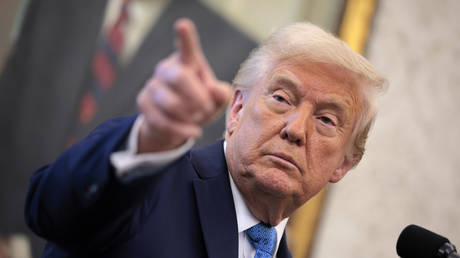 Trump suggests Canadians should vote for him
Trump suggests Canadians should vote for him
In his victory speech, Carney said he will deal with Trump in “full knowledge that we have many, many other options to build prosperity for all Canadians,” and pledged to maintain national independence.
In early March, Trump imposed a 25% tariff on most Canadian goods, citing concerns over trade imbalances and drug trafficking. Ottawa responded by introducing its own duties on US-made products.
Trump also argued that Canada would be better off as “the 51st state” of the US, provoking ire across the political spectrum in the run-up to elections.
Carney stated that during their phone call, he made it clear to Trump that Canada would, under no circumstances, become part of the US. “Absolutely not. Never. Move on,” he said.
Multiple media outlets argued that Trump’s tariffs and aggressive rhetoric had helped boost the Liberals’ popularity. “We were dead and buried in December. Now, we’re on track to form a government,” David Lametti, former Liberal Justice Minister, told CTV on Monday. “We’ve turned this around thanks to Mark,” he added.
-
Site: RT - News
Moscow wants the Ukraine conflict to end, the relative of the French statesman has told RT
Russian President Vladimir Putin’s proposed Victory Day ceasefire next month could pave the way to peace between Russia and Ukraine, Charles de Gaulle’s grandson Pierre has told RT.
Pierre de Gaulle made his remarks after Putin announced that Russian troops will observe a truce from May 8 through May 10, as their country commemorates the 80th anniversary of the defeat of Nazi Germany in World War II on May 9.
“The Russians are a peaceful people. Russia doesn’t want war. Russia wants peace,” de Gaulle told RT on Monday, welcoming the ceasefire announcement. “I think it’s a very strong symbol, as we celebrate the end of the Second World War,” he said.
“We’re also celebrating, I hope, the return of peace to Ukraine and the return of peace to Europe – a peace in which I would have hoped France could play a role.”
He argued that the current government in Paris was making “decisions contrary to common sense and reason.”
“But I hope that, in the long term, we can once again celebrate the Franco-Russian friendship – which is what my grandfather always wanted,” he said, adding that both nations would benefit from closer ties.
Read more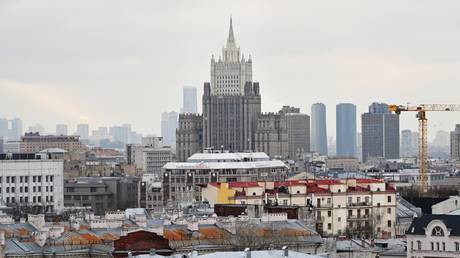 Paris ‘whispers’ about mending ties with Moscow – Lavrov
Paris ‘whispers’ about mending ties with Moscow – Lavrov
After leading the French resistance against Nazi occupation during World War II, Charles de Gaulle founded the modern French political system and served as president from 1959 until 1969.
In his statement on Monday, Putin urged Ukraine to honor the ceasefire, warning that Russian troops would “give a proportionate and efficient response” to any violations.
Ukrainian leader Vladimir Zelensky responded by accusing Moscow of “manipulation” and called for an immediate 30-day ceasefire.
According to Russia, Ukraine violated both the 30-day ‘energy truce’ brokered by the US last month and the 30-hour Easter truce, despite having promised to respect both arrangements. Putin has argued that in order for a comprehensive ceasefire to succeed, Kiev must halt its mobilization campaign and the West must stop delivering it weapons.
-
Site: Public Discourse
On February 18, U.S. District Judge Ana C. Reyes heard arguments surrounding the Trump administration’s executive order “Prioritizing Military Excellence and Readiness,” following a lawsuit from several current and would-be servicemembers who identify as transgender.
Section 2 of that executive order maintains that two factors stand at odds with the military’s “high standards for readiness, lethality, unit cohesion,” and other qualities. Those factors are, first, “the medical, surgical, and mental health constraints on individuals with gender dysphoria,” and second, “the use of pronouns that inaccurately reflect an individual’s sex.”
Much of the early news coverage centered on pronouns and, in particular, on Judge Reyes’s skepticism that they affect military readiness. Addressing the administration’s lawyers, she said: “You and I both agree that the greatest fighting force that world history has ever seen is not going to be impacted in any way by less than one percent of the soldiers using a different pronoun than others might want to call them.” In Judge Reyes’s view, a “military [that] is negatively impacted” because of transgender pronouns would be “incompetent.” She called the suggestion “frankly ridiculous” and said that “any common sense, rational person would understand that [pronoun use] doesn’t” affect military readiness.
The judge even issued the following challenge: “If you can get me an officer of the United States military to get on the stand and say that because of pronoun usage, we are less prepared, I will be the first to buy you a box of cigars.”
As an Air Force officer with a Ph.D. in philosophy who has personally struggled with the issue of transgender pronouns in the military, I am writing to meet this challenge. Importantly, I do so not out of “animus”—a common accusation surrounding this case—but with a sincere belief in the intrinsic worth of people who identify as transgender, with whom I have worked both personally and professionally, and whom I wish well. Nevertheless, the challenges that transgender pronoun use raise for our pluralistic military are real, and citizens need to understand them.
The use of transgender pronouns creates a dilemma for military readiness. So long as the military permits such pronouns, it has two basic choices: require their use or leave that use optional. Yet either choice brings real costs.
Choice 1: Require Use
Suppose the military required the use of transgender pronouns. To see the consequences, consider the following facts.
First, there are many people among us who cannot in good conscience use transgender pronouns. These include people who, for religious or philosophical reasons, believe that calling a biological male “she/her,” a biological female “he/him,” or calling someone any of the various other preferred pronouns such as “zi,” “zem,” or “fae,” amounts to a falsehood. The conscientious abstainers believe that their use of such language actually harms all parties involved: the speaker, who must violate his commitment to truth or his duties to God; the person who identifies as transgender, who will be encouraged in what the speaker believes to be a falsehood; and any other listeners, who may feel added social pressure to join, or continue, in that supposed falsehood.
Now, it is true that many people do not agree that transgender pronouns amount to a falsehood. This latter group sees the use of such pronouns as a mark of authenticity, even courage. But here I am focused on the former group, the conscientious abstainers. Their position gets little serious attention in most media coverage surrounding this issue, yet they need understanding too.
According to recent survey data, this group is not small. A 2022 Pew Forum study found that “[t]he vast majority of Republicans and those who lean toward the GOP say gender is determined by sex assigned at birth (86 percent),” along with “38 percent of Democrats and Democratic leaners”—a massive number in a country of 340 million people, with a relatively even split between the parties. If you believe that biological sex determines one’s gender, then calling a biological male who identifies as a woman “she/her” (for example) will be for you direct participation in a lie.
That may help to explain why, according to a PRRI study from 2023, 43 percent of Americans reported that they were “somewhat” or “very uncomfortable” using “pronouns like ‘he’ or ‘she’ that do not match your perception of their appearance.” That figure includes 68 percent of Republicans, 40 percent of Independents, and 33 percent of Democrats—again, a massive number.
Nor, for many of these people, will the supposed falsehood appear innocent. A study by Gallup in May 2024 found that a “steady 51 percent of Americans think changing one’s gender is morally wrong,” and many of those cited religious reasons, meaning their opposition is not surface-level but goes very deep, even into First Amendment territory. Although that study focuses on more extreme means of transition (puberty blockers and hormone treatments, for example), such treatments exist along a spectrum, and changing one’s pronouns surely falls along that spectrum.
Thus, were the military to require the use of transgender pronouns, it would alienate a substantial portion of eligible citizens, who may conclude that it is no longer safe to serve, since doing so exposes them to a not-insignificant chance of being forced to violate their conscience. This chance greatly increases when viewed over the course of a twenty-year career, with the myriad colleagues that will come into their path. Instituting such an obstacle to military service for so many citizens poses a clear readiness problem.
Choice 2: Leave Use Optional
Suppose instead that the military leaves it optional whether or not to use transgender pronouns. This too creates a readiness problem, in two distinct ways.
First, although many Americans cannot use transgender pronouns, others view that refusal as an existential threat, a “denial” of the transgender person’s “very existence.” Claims about this erasure of existence are numerous. (See, for example, here, here, and here.) As such people see it, to deny the requested pronoun (and the beliefs on which it is based) is to deny that the requesters are who they claim themselves to be; it is to deny the real them. The coexistence of these two groups—the pronoun abstainers and the pronoun requesters—provides a recipe for immense tension in a military unit, as one group demands what the other group cannot, in good conscience, give. It does so, at the very least, so long as such pronouns are optional, for then members can be found culpable for not using them.
That tension intensifies when we consider that many of today’s prominent voices portray all who refuse to use transgender pronouns—or to support other aspects of a transition program—as bigoted or hateful, even when abstainers state their reasons clearly and in gracious terms. (See, for example, the 2018 controversy surrounding Isabella Chow, a former UC Berkeley student senator—a case I explored in detail in my doctoral dissertation.)
Now because our military is pluralistic, it contains representatives of both groups: those who cannot use transgender pronouns, and those who either demand their use or who regard abstainers as bigoted or hateful. Thus, a portion of servicemembers declining to use transgender pronouns could easily undermine trust and cohesion in the unit, while alienating servicemembers who identify as transgender. This is hardly a recipe for success.
Those who wish to understand these two groups better, and therefore to engage in more productive dialogue about pronouns and related issues, might start by reading the entries on “gender identity” and “transgender” in the Red Blue Translator, a resource from the public benefit corporation AllSides. Such awareness can humanize opponents, while clarifying conflicts that seem inexplicable when one does not know the basic assumptions of the other side.
There is a second way in which the optional use of transgender pronouns can damage military readiness. Certain aspects of military culture create immense pressure on servicemembers to use transgender pronouns, regardless of whether such pronouns are theoretically optional or whether they align with such servicemembers’ beliefs. Consider the following scenarios.
A commander of an Air Force squadron has been asked to officiate the promotion ceremony of one of her airmen, a person who identifies as transgender. It is customary in the Air Force that the officiant make remarks on behalf of the promotee. These remarks are often personal, summarizing major milestones in the promotee’s life and career—they often last for ten minutes or more. The promotee’s family is usually present, along with his teammates.
What, then, is our commander to do? All eyes (and ears) now rest upon her, with the expectation that she will help make the occasion special. And though she wishes to make it special, she belongs to that large group of people who object to using transgender pronouns.
Have you ever tried to omit pronouns when speaking about someone who identifies as transgender? Planned every sentence in advance? Heard the awkwardness as you repeat the person’s name again and again, rather than the graceful alternation between name and pronoun that our language affords? If so, then you can appreciate just how difficult our commander’s task is. Perhaps we can trust seasoned leaders with that challenge, but what about 18-year-old recruits or your average mid-level supervisor? Are they up to it?
And if they fail, what then? Will they be subject to an Equal Opportunity (EO) complaint, or even a violation of the Uniform Code of Military Justice on harassment grounds? This may sound far-fetched, but one military lawyer and professor at West Point has argued that EO law supplied such a basis as recently as last year.
And what should that airman’s teammates in the audience infer from their commander’s abstention? That she is a bigot and full of hate, as many allege? So much for unit cohesion.
Next, take the case of a junior servicemember who serves under a civilian leader—a government service (GS) employee who identifies as transgender. How should our servicemember address the leader in question in all his interactions with that person?
This case is especially difficult for multiple reasons. Unlike in the previous scenario, where the commander could at least alternate between using the airman’s rank and his or her first name, the servicemember in our new scenario has no such option. There are no gender-neutral titles for civilian employees. You would not call someone “GS-15 Smith,” for example, whereas you can and do call someone “Colonel” or “Airman Smith.” In the civilian case, one uses “Mr.” or “Ms.,” “Sir” or “Ma’am,” a custom which leaves conscientious abstainers no way out.
Unlike many civilian organizations, which are “flat” in nature, the military is strictly hierarchical, and it adheres to time-honored customs and courtesies. In our current system, many would consider it extraordinarily inappropriate for a junior servicemember to refer to civilian leaders by their first names, or to use titles like “boss.” This especially applies to major political appointees (service secretaries, for example). Were such people to request alternative pronouns, that could create a crisis of conscience for tens of thousands of their subordinates, who may either fear reprisal or the assumption of animus from many of their non-abstaining teammates.
In short, so long as the military permits transgender pronouns, it faces a dilemma. To require their use means alienating a substantial percentage of eligible servicemembers who cannot use them in good conscience. To leave them optional threatens unit cohesion, and it risks the continued alienation of those who, given the nature of military culture, see no genuine room for abstention.
Judge Reyes, and all those holding authority over our nation’s armed forces, should take the real dangers posed by a culture of pronoun usage—whether mandatory or “optional”—seriously.
The views expressed here are his own and do not reflect the official guidance or position of the United States Government, the Department of Defense, the United States Air Force, or the United States Space Force.
Image by roibu and licensed via Adobe Stock.
-
Site: Zero HedgeIran Says Port Blast Was 'Negligence' Amid Reports Missile Fuel Stored ImproperlyTyler Durden Mon, 04/28/2025 - 19:40
As of Monday an Iranian official in Bandar Abbas has said that the major Iranian port fire is 90% extinguished, which means emergency crews have been battling the blaze for over 40 hours. The death toll has since risen to at least 46 amid the ongoing emergency. Over 1,000 injuries have been reported.
The massive, deadly explosion which shocked Iran two days prior is the largest at an Iranian commercial port. The resulting fire ball, partly the result of missile fuel reportedly having detonated, was so large that there was initial widespread speculation that the Israelis were behind it.
 Via Associated Press
Via Associated Press
Certainly it wouldn't have been the first Israeli sabotage attack against vital Iranian infrastructure in recent history. And so it is somewhat of a surprise that the Iranians on Monday have not alleged any kind of external sabotage or interference, but are instead calling it an accident due to negligence
Iran’s Interior Minister Eskandar Momeni described the blast at the nation's largest commercial port two days earlier as caused by "negligence" and failure to comply with established safety measures. There is an ongoing investigation.
"Some culprits have been identified and summoned… There were shortcomings, including noncompliance with safety precautions and negligence in terms of passive defense," Momeni told state TV. He suggested that some materials should not have been kept at the port.
Drone closeup footage from aftermath of Iran port blast released by an IRGC linked outlet. pic.twitter.com/2eGPaMW1rw
— Khosro K Isfahani (@KhosroIsfahani) April 28, 2025According to The NY Times, a volatile component was improperly stored:
A person with ties to Iran’s Islamic Revolutionary Guard Corps said that what exploded was sodium perchlorate, a major ingredient in solid fuel for missiles. The person spoke on condition of anonymity to discuss security matters.
The state-run Islamic Republic News Agency quoted an official as saying the explosion was likely set off by containers of chemicals, but did not identify the chemicals. What caused them to detonate was not clear, but the Iranian authorities did not suggest it was sabotage or a deliberate attack.
Reddish-orange clouds over the area have further suggested a significant chemical component to the blast, and Iran's health ministry has declared a state of emergency in the impacted Hormozgan province.
On-the-ground video of the still-smoldering aftermath...
❗️Iran’s LARGEST port looks apocalyptic — craters, smoke everywhere, 10,000 containers destroyed, fire still raging, 40 DEAD, 1,000+ injured https://t.co/97e7BuuD5X pic.twitter.com/rtoMSiqa2G
— RT (@RT_com) April 27, 2025The ministry is warning of airborne toxic pollutants and is urging people to stay indoors and to keep windows closed and wear masks. The fact that the port will have to be halted for a significant amount of time is expected to unleash harm and uncertainty on the already isolated Iranian economy.
-
Site: Edward FeserIn my latest essay at Postliberal Order, I discuss what Christ, the Fathers of the Church, and Aristotle have to say about the moral hazards of riches.
-
Site: Zero HedgeLeftism Is Killing ChocolateTyler Durden Mon, 04/28/2025 - 19:15
Authored by Andrew Widburg via AmericanThinker.com,
After years of writing about politics, I’m a pretty hardened character. I’m cynical, pessimistic, and, while I’m often disgusted, I’m seldom shocked or panicked. But what I read at the JoNova site was so terrible I’m reeling: “Price fixing kills the cocoa farm.” It turns out that, thanks to price controls in Ghana, one of the world’s primary chocolate-producing countries, chocolate farmers aren’t even bothering to plant new crops. Honestly, I feel quite ill.
I love chocolate at a level that comes close to (but I hope never crosses into) being idolatrous. It is one of the greatest pleasures in my life. Every day, I nibble at my Guittard Extra Dark Chocolate Chips, which, to my mind, are the best around: not too sweet, with a perfectly balanced fruity, vanilla undertone. Also, when the spirit moves me and the freezer isn’t too full, I make what is quite possibly the best chocolate ice cream around, using Droste Cocoa (worth every penny), along with hints of caramel and almond.
When I say I take chocolate seriously, I am not exaggerating. I consider it essential. So, when I read that socialist price-fixing policies in Ghana (as opposed to the leftists’ delusional bugaboo of anthropogenic climate change) are threatening the world’s cocoa supply...well, I’m getting ready to place a big chocolate order, that’s all I can say.
Jo Nova, one of Australia’s top real science writers (as opposed to the faux, leftist science writers), has the story:
There has been a wicked price spike in cocoa beans which the usual suspects are blaming on “climate change” as if your air conditioner was ruining cocoa crops in West Africa.
Instead African governments have fixed the price of cocoa for decades, forcing poor farmers to work for a pittance, and keeping the big profits for themselves.
Not surprisingly, even though there is a wild price spike, farmers in Ghana are leaving the industry, smuggling crops out (because they get a better price).
They didn’t plant new trees, they ran out of money for fertilizer, and didn’t try new varieties.
Their children don’t want to farm cocoa, and the yields are falling on old sickly plantations.
So, surprise, socialist government controls wrecked the industry and they are now scrambling to put the pieces back together.
Things are so desperate, the government of Ghana raised the price of cocoa by 58% last April and then raised the price of cocoa by another 45% last September, to try to reduce the smuggling.
(The government was losing too much money).
At one point last year it was estimated that a third of the national crop was lost to smugglers.
A few months after this, the farmers were hoarding their beans in expectation the government would have to give them another price rise. Just chaos for everyone.
Of course, that’s just the top note of an excellent essay that isn’t just about chocolate but, instead, uses the chocolate debacle as a springboard to discuss how socialism perverts markets, diminishing available supplies and impoverishing ordinary people. It’s worth your time to check it out.
So, next time you hear a chocolate lover bemoan the price of chocolate and, naturally, blame climate change for that situation, be sure to direct your friend to Jo Nova’s article. Your friend might learn something. Indeed, because every person has his or her truth, the one thing that matters most to him, your friend might suddenly decide that the free market is a good thing.
-
Site: The Remnant Newspaper
-
Site: Zero Hedge"ENEMY OF THE PEOPLE": Trump Rages After Negative Polls, Demands InvestigationsTyler Durden Mon, 04/28/2025 - 18:50
President Donald Trump on Monday said that pollsters reporting a recent slide in approval ratings should be investigated for "election fraud" over how wrong they were during his reelection campaign, as the country approaches Trump's 100th day in office and markets continue to pivot over chaotic messaging.
Citing recent polls from the NYT, WaPo, ABC News, and Fox News, Trump wrote on Truth social on Monday: "They are negative criminals who apologize to their subscribers and readers after I win elections big, much bigger than their polls showed I would win, loose a lot of credibility, and then go on cheating and lying for the next cycle, only worse," adding "These people should be investigated for ELECTION FRAUD, and add in the FoxNews Pollster while you’re at it."
"They suffer from Trump Derangement Syndrome, and there is nothing that anyone, or anything, can do about it. THEY ARE SICK, almost only write negative stories about me no matter how well I am doing (99.9% at the Border, BEST NUMBER EVER!), AND ARE TRULY THE ENEMY OF THE PEOPLE! I wish them well, but will continue to fight to, MAKE AMERICA GREAT AGAIN!" Trump continued.
That said, Trump's approval rating hasn't slipped that much according to a recent WaPo-ABC News poll - which found that 55% of adult Americans disapprove of the way he's handling his job vs. February at 53% disapproval.
The same poll found that Trump's approval rating is the lowest for any past president at the 100-day mark in their first or second terms.
Fox News, meanwhile, found that voters are displeased with Trump on just about every issue aside from border security.
Overall approval of Trump’s job performance comes in at 44%, down 5 points from 49% approval in March. That’s lower than the approval of Joe Biden (54%), Barack Obama (62%), and George W. Bush (63%) at the 100-day mark in their presidencies. It’s also lower by 1 point compared to Trump’s 45% approval at this point eight years ago.
Some 59% of voters are unhappy with how things are going in the country. That’s an improvement since the end of former President Biden’s term (68% dissatisfied), but worse than four years ago at the beginning of Biden’s term (53% dissatisfied). It’s also worse than the 100-day mark of Trump’s first term (53% dissatisfied). Since his inauguration in January, satisfaction among Democrats has turned to dissatisfaction and vice versa among Republicans. Dissatisfaction remained steady among Independents.
There were 4 national polls released today. All of them show the same thing. Trump’s approval is crashing and it’s directly tied to how Americans feel he is handling the economy, and particularly tariffs.
— AG (@AGHamilton29) April 28, 2025
The economy went from his strongest issue to his weakest due to tariffs. pic.twitter.com/Wb9Ar1LO33What say you?
First 100 days for Trump
— The_Real_Fly (@The_Real_Fly) April 28, 2025 -
Site: RT - News
It is “weird” to expect Russia to collapse, the US vice president has said
Ukraine is not poised to win the conflict with Russia, US Vice President J.D. Vance has said. He added that it would be naive to expect the larger country’s collapse if fighting continues for several more years.
Vance, a US Marine Corps veteran, has long contended that American support for the war in Ukraine diverts resources from domestic priorities and risks unnecessary conflict with Russia.
“If this doesn’t stop, the Ukrainians aren’t winning the war,” Vance said during an interview with Charlie Kirk during the conservative activist’s podcast on Monday.
“I think there’s this weird idea among the mainstream media that if this thing goes on for just another few years, the Russians will collapse, the Ukrainians will take their territory back, and everything will go back to the way that it was before the war. That is not the reality that we live in,” the vice president said.
“You could have millions of more people killed if this thing goes on for another few years, and it could risk escalating into a nuclear war. It has to stop,” Vance added.
American negotiators are “making progress,” despite the challenges of dealing with both sides, Vance claimed.
Read more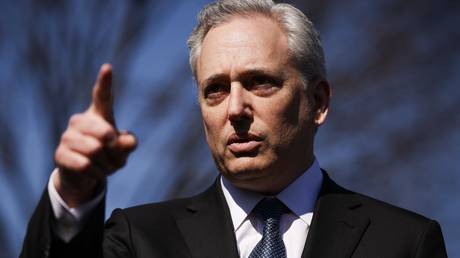 Russians ‘not our enemy’ – Trump adviser
Russians ‘not our enemy’ – Trump adviser
“Sometimes you’re incredibly frustrated with Ukrainians. Sometimes you’re incredibly frustrated with the Russians,” Vance said. “And sometimes you just want to throw your hands up, but that’s what President Trump doesn’t let us do.”
Vance’s remarks came as Russian President Vladimir Putin announced that Russian troops would observe a three-day ceasefire starting on May 8 to commemorate the Soviet Union’s victory over Germany in World War II. Ukrainian leader Vladimir Zelensky responded by accusing Moscow of “manipulation” and called for an immediate 30-day ceasefire.
According to Russia, Ukraine violated both the 30-day ‘energy truce’ brokered by the US last month and the 30-hour Easter truce, despite having promised to respect both arrangements. Putin has argued that in order for a comprehensive ceasefire to succeed, Ukraine must halt its mobilization campaign and the West must stop delivering weapons to Kiev.
-
Site: Zero Hedge"The Federals Are Coming!"Tyler Durden Mon, 04/28/2025 - 18:25
Authored by Jeff Thomas via InternationalMan.com,
Americans were taught about Paul Revere’s ride in school. He was said to have ridden from his home in the North End of Boston, to Lexington and Concord, to warn the people there that Federal troops had landed in Boston Harbour and would soon reach the townships.Of course, the story was tarted up a bit for the history books. First, it’s unlikely that he shouted, “The British are coming,” since, at the time of the ride, in 1775, he was in fact British – a British colonial – and would have regarded himself as British, as would the townspeople.
It’s also unlikely that he galloped through the towns shouting, “To arms! To arms!” since a major portion of the British colonists, particular those who were older and had a lot to lose, were loyalists, and taking up arms would be treasonous. (At that time, treason was one of only two capital crimes.)
So, what did he shout on his ride… or did he in fact shout anything? It’s more likely that he simply went to the back doors of select sympathisers and asked them to spread the word that the Federal troops were on the way. But, of course, that would have made for a far less colourful story.
It is likely, though, that the ride itself did actually take place and that he did succeed in rousing the townspeople. Amongst them were the minutemen, who later did quite a good job of picking off the Federal troops.
At that time, this practice was looked upon by armies as cowardly. It was considered honourable for columns of troops to march toward each other and fire. Those with the most troops to sacrifice usually won. The colonists could not have prevailed, had they followed this method of battle.
But the colonists’ cause was a laudable one, even if they were far outnumbered and not as well-trained or well-armed as the Federals. Under the circumstances, they succeeded because they swallowed their pride, used their wits and, fighting guerilla style, prevailed against a greater opponent.
In creating the United States, the founding fathers of the US endorsed the concept of a republic – a conglomerate of states in which the individual right was tantamount. They were deeply suspicious of sliding into becoming a democracy. As Thomas Jefferson said,
“Democracy is nothing more than mob rule, where 51 percent of the people may take away the rights of the other 49.”
Quite so. And yet, from the very first presidential cabinet, Secretary of the Treasury Alexander Hamilton pushed for a move away from a republic toward a stronger federal government. (In 1789, he formed the Federalist Party and the contest began.)
Since that time, the US has moved away from being a republic and has become more of a federalist state.
This progression continued fairly steadily until 1913, at which time two major changes occurred. The banking interests in the US had become powerful enough to push through two bills that would serve to enrich them for generations. The source of that wealth would be the American taxpayer.
-
First, income tax (which had been attempted previously, but never gained full acceptance) was introduced.
-
Second, to add insult to injury, the Federal Reserve was created. It was neither a federal body, nor was it a reserve. However, in addition to having the power to create all currency for the US, it had the power to set interest rates.
Through this control, it was possible to create steady annual inflation (defined as an increase in the currency in circulation). This had the effect of diminishing the purchasing power of the dollar by slow measures, effectively robbing the population incrementally through inflation.
Had Paul Revere been around in 1913, he might well have wished to get on his horse to warn the people that the Federals were coming. Only this time, it wasn’t the Federal troops, it was the Federal Reserve.
The Fed’s power made it possible to create large amounts of money out of thin air, to be loaned by banks. With this easy money, investors could borrow heavily and buy into the stock market a level previously regarded as impossible. This cornucopia was so forthcoming that, by 1929, a level of debt was reached that was unsustainable. If even a small increase in the interest rate was advanced, a stock market crash would occur, as debtors, who were up to their teeth in debt, would be underwater overnight.
What’s interesting here is that the very body that had taken over the economy in 1913 – the Federal Reserve – had created the artificially low interest rates, supplied the money, created the bubble, then, by raising interest rates in 1929, provided the pin to prick the bubble.
Not very sporting.
Today, the value of the dollar has been eroded by over 97% of its 1913 purchasing power and is due for replacement. If the owners of the Federal Reserve are to continue to regularly scalp the hoi polloi, the best approach would be to engineer a second major buildup of debt, trigger a crash, then introduce a new currency to “save the economy.”
This, they will most assuredly do. The debt has already been created. A crash can be triggered in many ways, including the tried-and-true method of raising interest rates.
And, after the predictable crash, the public will most assuredly cry out for those in power to “do something.” The warning signs have been in view for some time that that “something” will be digital currency – a currency that will make it necessary for virtually all economic transactions to pass through the hands of banks. Person-to-person transactions will virtually end, except for the possibility of barter, which would be likely to flourish as soon as the public have realized that they’ve been hoodwinked.
Unfortunately, our friend Paul Revere is nowhere to be seen on the horizon, but the Federals are indeed coming and the American people, in the not-too-distant future, will need to learn to survive the onslaught from the digital currency system that will take the place of the bullets of the late eighteenth century.
Once again, Americans will need to understand, as did their late eighteenth century forebears, that their only hope against a more powerful opponent is to use their wits – to adopt the minuteman approach and implement the economic equivalent of guerilla warfare.
* * *
Excessive money printing and misguided economic ideas have created all kinds of distortions in the market. All signs point to this trend continuing until it reaches a crisis… one unlike anything we’ve seen before. That’s exactly why Doug Casey and his team just released an urgent video that explains how and why this is happening… and what you can do to protect yourself and even profit from the situation. Click here to watch it now.
-
-
Site: LifeNews
“A fetus isn’t a baby.” “A woman has a right to choose.” These are often the most common statements a pro-lifer hears when discussing abortion with pro-choice people. “It isn’t a baby until it’s born.” “Abortion isn’t killing.”
The rank-and-file of the pro-choice movement usually deny that an unborn baby is a human being with a right to life. Occasionally you will find someone who argues that the fetus is a baby, but the woman has a right to abort him or her anyway – but usually you’ll hear pro-choice people denying the humanity of the unborn.
One word that’s always avoided is pro-choice publications is “baby.” “Fetus” or “product of conception” or “tissue” is how the aborted baby is described. It isn’t a life, they say.
But the people who know the most about abortion are the clinic workers and doctors who perform them. And many of them have come out saying things that would make even the most hardcore pro-choicers cringe.
Follow LifeNews.com on Instagram for pro-life pictures and videos.
In one article in the American Medical News that was probably never meant for pro-life eyes, abortion providers from around the country discussed the emotional difficulties of performing abortions. One doctor said:
I have angry feelings at myself for feeling good about grasping the calvaria [head], for feeling good about doing a technically good procedure that destroys a fetus, kills a baby. (1)
Baby? Perhaps this doctor didn’t get the memo. Pro-choice activists know never to refer to the “fetus” as a baby. You won’t hear Reproductive Freedom for All (formerly NARAL Pro-Choice America) or the National Organization for Women using the term “baby” to describe a child being aborted.
Another abortion doctor uses honest terms to describe his job:
A late termination is actually not very nice and there is no way of getting away from it, I don’t feel I am doing it for any other reason than for the best of both the mother and the baby. (2)
Again the word “baby.” Could it be that these abortionists are fully aware that the “fetuses” they are aborting are in fact living babies?
If there is any doubt that at least some abortion providers know that abortion is killing a baby, it is put to rest by British abortionist Judith Arcana:
It is morally and ethically wrong to do abortions without acknowledging what it means to do them. I performed abortions, I have had an abortion and I am in favor of women having abortions when we choose to do so. But we should never disregard the fact that being pregnant means there is a baby growing inside of a woman, a baby whose life is ended. We ought not to pretend this is not happening. (3)
This straightforward admission must have caused some consternation to pro-choice activists who read Arcana’s article. Few are willing to admit to the reality of abortion.
One unnamed abortionist said the following in a book that profiled doctors from different fields:
Nobody wants to perform abortions after ten weeks because by then you see the features of the baby, hands, feet. It’s really barbaric. Abortions are very draining, exhausting, and heartrending. There are a lot of tears. … I do them because I take the attitude that women are going to terminate babies and deserve the same kind of treatment as women who carry babies … I’ve done a couple thousand, and it turned into a significant financial boon, but I also feel I’ve provided an important service. The only way I can do an abortion is to consider only the woman as my patient and block out the baby[.] (4)
In this short paragraph, the doctor mentions the word “baby” four times.
It is clear that many abortion providers know that they are ending life. They see the babies kicking and moving on the ultrasound screen and then see them later, in pieces, in the back room of the clinic.
Clinic counselor Tim Shuck, who worked at the Lovejoy abortion clinic until his death from AIDS, said the following to a writer who was chronicling the daily workings of the clinic:
I have never denied that human life begins at conception. If I have a complaint about our society, it’s that we don’t deal with death and dying. Do we believe human beings have a right to make decisions about death and dying? Yes we do, and those decisions are made every day in every hospital. (5)
The author who quoted Shuck never revealed whether or not Shuck told the women he counseled that life begins at conception.
Another clinic worker said the following:I see more of murder the further along they get. Although inside me I know it’s murder from the beginning… (6)
In an article in the Dallas Morning News, abortion clinic administrator Charlotte Taft made the following statement:
We were hiding … some pieces of the truth about abortion that were threatening. [Abortion] is a kind of killing, and most women seeking abortion know that. (7)
This was a little too much honesty for Planned Parenthood – after the late Taft came out with this statement, they stopped referring patients to her clinic. Eventually, she resigned.
Reporter Leonard Stern spoke to Joan Wright, the owner of a clinic in Ottawa. She explained how she and her fellow workers were fighting to force pro-lifers to take down a banner that announced, “Abortion Stops a Beating Heart” and gave a phone number for women considering abortion to call for help. Stern confronted her with pro-lifers’ allegations that her clinic gave deceptive counseling to women. From the article:
She said. “Good grief! They accuse us of pretending we’re not doing what we’re doing? I’m in the business of death!” (8)
This is probably the most honest and frank admission by an abortion provider that you are likely to hear.
In his essay “Why I Am an Abortion Provider,” Dr. William F. Harrison says the following: “No one, neither the patient receiving the abortion, nor the person doing the abortion, is ever, at any time, unaware that they are ending a life.”
In reality, the fact that abortion ends a life is often hidden from women. The baby is described as “products of conception” or “tissue.” The abortion “empties out the uterus.” The facts of fetal development are glossed over or outright distorted. The woman is facing a life-changing, irrevocable decision at a vulnerable time in her life, and she is susceptible to being deceived.
Look at the way one abortion clinic (Summit Medical Center) describes an abortion on its website.
You will first lay [sic] on an exam table like you would’ve for regular gynecological exam. Most patients will then receive IV sedation/twilight anesthesia… Patients opting for twilight anesthesia are mildly awake, but should feel no more than slight (if any) discomfort, and usually have little or no memory of the procedure afterwards.… Just as with a Pap smear, the doctor will use a speculum to hold the vaginal walls open, and then begin the procedure of using a series of dilation instruments to open the cervix. The contents of the uterus are then removed with a gentle vacuum aspirator.
Here are more examples of abortionists and clinic workers who acknowledge that abortion is killing:
The owner of one abortion clinic, identified only as “Michelle” in a book by James D. Slack, said the following:
I’ve thought through this issue, to do it as long as I have, and I have to sleep well at night… Is it life? Clearly it’s life. Does it deserve protection? My answer is “no.” The bottom line, you have two competing interests: the mother and the baby (or the embryo or the fertilized egg). And sometime during that nine month gestation, a woman’s rights are going to digress. At that point, I guess, rights can be ascribed to the fetus. (9)
This clinic owner has no problem calling an embryo a baby. She merely considers the baby’s life unimportant. There is no doubt that she knows exactly what is happening at her clinic.
Abortionist Don Sloan, explaining the morality of abortion to his teenage niece in an essay that appeared in an anthology on abortion, said the following:
Is abortion murder? All killing isn’t murder. A cop shoots a teenager who appeared to be going for a gun, and we call it justifiable homicide – a tragedy for all concerned, but not murder. And then there’s war… (10)
In this case, the abortionist (Sloan had been practicing for over thirty years and has done over 20,000 abortions) admits that abortion is killing but claims that it is not murder. He equates abortion with self-defense and war. But is the unborn baby sleeping in her mother’s womb really an aggressor?
Except in very rare cases, a woman’s life is not endangered by a pregnancy. And unless the pregnancy is a result of rape (which is a factor in only 1% of all abortions) the woman’s own actions (along with those of the baby’s father) resulted in the baby developing where he or she is. The baby may be unwanted, but she is not truly an intruder if the woman’s own actions are responsible for her presence in the womb. An unborn baby is not a teenager with a gun or an enemy soldier on a battlefield; she is an innocent and helpless member of the human race.
Abortionist Dr. Neville Sender said the following in a newspaper article:
We know that it is killing, but the states permit killing under certain circumstances. (11)
The clinic where Sender worked later came under scrutiny for throwing the bodies of aborted babies in the trash.
Abortionist Dr. Curtis Boyd, who performs abortions up to 24 weeks: “Am I killing? Yes, I am. I know that.” You can see a video of him saying it here.
Another abortionist, who remained anonymous, said:
It [the fetus] is a form of life[.] … This has to be killing[.] … The question then becomes, ‘Is this kind of killing justifiable?’ In my own mind, it is justifiable, but only with the informed consent of the mother. (12)
Another abortionist admits that abortion is killing but also tries to justify it by saying the babies he kills would have difficult lives if they were allowed to be born:
I have the utmost respect for life; I appreciate that life starts early in the womb, but also believe that I’m ending it for good reasons.
Often I’m saving the woman or I’m improving the lives of other children in the family. I also believe that women have a life they have to consider. If a woman is working full-time, has one child already and is barely getting by, having another child that would financially push her to go on public assistance, yes that is going to lessen the quality of her life. And it’s also an issue for the child, if it would not have had a good life. Life is hard enough when you’re wanted and everything’s prepared. So yes, I end life, but even when it’s hard, it’s for a good reason. (13)
Are these good reasons to kill a child?
Another abortionist puts it more plainly:
Abortion is killing the fetus. … Human life, in and of itself, is not sacred. Human life, per se, is not inviolate. (14)
This doctor has foregone excuses and accepted the belief that human life is not sacred or worthy of protection. He has no need for justifications. He knows he is killing – and he doesn’t care.
After talking extensively to one abortionist, author Nancy Dey writes:
Dr. Ed Jones (pseudonym) says it’s always in the back of his mind that he is terminating a life. (15)
Another abortionist, Dr. Harrison, simply said, “I am destroying a life” (16). This doctor has performed over 20,000 abortions.
Dr. William Rashbaum performed thousands of abortions before his death in 2005. He revealed to an interviewer that he was haunted by a recurring nightmare of an unborn baby hanging on to the uterine wall with its tiny fingernails, fighting to stay inside. When asked how he dealt with this dream, he said, “Learned to live with it. Like people in concentration camps.”
The interviewer then asked if he really meant that metaphor:
I think it’s apt – destruction of life. Look! I’m a person, I’m entitled to my feelings. And my feelings are who gave me or anybody the right to terminate a pregnancy? I’m entitled to that feeling, but I also have no right communicating to the patient who desperately wants that abortion. I don’t get paid for my feelings. I get paid for my skills… I’ll be frank. I began to do abortions in large numbers at the time of my divorce when I needed money. But I also believe in the woman’s right to control their biological destiny. I spent a lot of years learning to deliver babies. Sure, it sometimes hurts to end life instead of bringing it into the world. (17)
Rashbaum knew that abortion takes a life, but he never mentioned this to the women who were coming in for abortions. One can only wonder about the psychological strain of equating oneself with a Nazi, with knowing that you end babies’ lives for a living.
Pro-choice writer Miriam Claire interviewed several abortion providers for a book she wrote. One of them, Dr. Bertram Wainer, said the following:
My whole professional training was to prolong life, to nurture and protect it. Abortion is clearly at odds with that ethos … [yet] I have never refused to perform an abortion because of any personal conflict[.] (18)
There are other examples of abortionists and clinic workers who admitted that abortion ends lives. Magda Denes, a pro-choice author, interviewed a number of doctors and clinic workers in her book In Necessity and Sorrow: Life and Death Inside an Abortion Hospital. Every doctor she interviewed, and many of the clinic workers, admitted at some point during the interviews that they regarded abortion as murder. One doctor said:
It [abortion] goes against all things which are natural. It’s a termination of a life, however you look at it. (19)
There are similar quotes throughout the book.
There is no way to know for whether or not these doctors and clinic administrators are representative of all abortion providers. But it is clear that many, if not most, abortion providers know that they kill. It is also clear that the average pro-choice person, who argues in support of allowing these men and women to continue practicing, has no awareness of the truth that so many abortion providers know – that abortion kills babies.
1. Diane M. Gianelli, “Abortion Providers Share Inner Conflicts,” American Medical News, July 12, 1993
2. ABC.net: Religion and Ethics: 12-28-2005. Quoted by Life Dynamics
3. Judith Arcana “Feminist Politics and Abortion in the US” Pro-Choice
Forum (Psychology and Reproductive Choice) Sponsored by The Society for the Psychology of Women.
http://www.prochoiceforum.org.uk/psy_al8.php4. John Pekkanen. M.D.: Doctors Talk About Themselves (Delcorte Press: New York, 1988) 90-91
5. Peter Korn. Lovejoy: A Year in the Life of an Abortion Clinic (The Atlantic Monthly Press: New York, 1996) p 94
6. James Tunstead Burtechaell, C.S.C. Rachel Weeping: the Case against
Abortion (San Francisco, CA: Harper & Row Publishers, 1982) 135 – 1367. “Abortion rights activist resigns as clinic director; Taft cites differences with Routh Street owner” Dallas Morning News 2/2/1995
8. Leonard Stern “Abortion Wars” The Ottawa Citizen Sun 28 May 2000
9. James D Slack Abortion, Execution, and the Consequences of Taking Life (New Brunswick: Transaction Publishers, 2009) 49
10. Tamara L. Roleff. Abortion: Opposing Viewpoints (Greenhaven Press: San Diego 1997) 25
11. John Powell, S.J. Abortion: The Silent Holocaust (Argus Communications: Allen, Tx) 1981, p 66
12. Democrat & Chronicle 7/5/92
13. Cheryl Alkon “Confessions of an Abortion Doctor” Boston Magazine December 2004
14. Abortionist “Dr. Smith” (Pseudonym) . Leo Wang “The Abortionist”
Berkeley Medical Journal Spring 199515. Nancy Dey Abortion: Debating the Issue (Enslow Publishers: Springfield, IL 1995) 49
16. Nat Hentoff “An Abortionist’s World: How to Rationalize
Inhumanity” The Washington Times Febuary 6, 2006. Citing Stephanie Simon “Offering Abortion, Rebirth” Los Angeles Times November 29, 200517. Norma Rosen “Between Guilt and Gratification: Abortion Doctors
Reveal Their Feelings,” New York Times Magazine April 17, 1977 p 73, 74, 7818. Miriam Claire The Abortion Dilemma: Personal Views on a Public Issue. (Insight Books: New York) 1995, p 30
19. Magda Denes, PhD. In Necessity and Sorrow: Life and Death Inside an Abortion Hospital (Basic Books, Inc.: New York 1976)147
LifeNews Note: Sarah Terzo covered the abortion issue for over 13 years as a professional journalist. In this capacity, she has written nearly a thousand articles about abortion and read over 850 books on the topic. She has been researching and writing about abortion since attending The College of New Jersey (class of 1997) where she minored in Women’s Studies. This article originally appeared on Sarah Terzo’s Substack. You can read more of her articles here.

The post Abortionist Admits That Abortion “Kills a Baby” appeared first on LifeNews.com.

